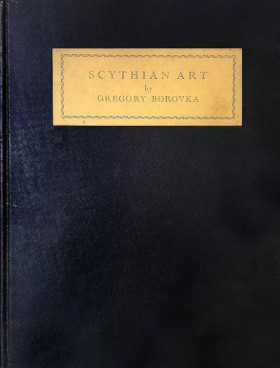 G.I. Borovka
G.I. Borovka
Scythian Art.
// London: Ernest Benn, Ltd. 1928. 111 pp., 74 pl.
Scythian Art.
[ńŽˇ ůšÓŠŮÚ‚ŗ ‚ ÚŚÍŮÚ ÍÓŚ-„šŚ šÓŠŗ‚ŽŚŪŻ ŤŽŽĢŮÚūŗŲŤŤ,
ÍŗÍ ŗ‚ÚÓūŮÍŤŚ ÚŗŠŽŤŲŻ (Ůž. ŮÔŤŮÓÍ), ÚŗÍ Ť šÓÔÓŽŪŤÚŚŽŁŪŻŚ.]
The centuries preceding and following the year 1000 b.c. were a veritable age of national migration. About that time the invasion of the west Indo-European tribes, of the Greeks and the Italici, and the advance of the east Indo-European Medes and Persians finally shattered the great pre-classical civilizations. Approximately at the same epoch the whole vast ocean of peoples, grouped together by the Greeks under the collective name of Scyths, was set in violent motion. Of the causes of these mighty popular movements in the vast steppe region north of the Caucasus and Iran we know practically nothing. The history of those regions in pre-classical times is almost a sealed book. Even for the classical epoch our sources of information are exiguous and the archaeological record is still inadequately studied; before we can interpret it, the material must be comprehended in its inner significance. We can only suggest hypothetically that all these popular movements, the western and the eastern alike, were interrelated and are to be regarded as a single great phenomenon.
Still one ultimate result of this migration of ďScythianĒ tribes does come fully within our ken. The westernmost of these peoples, the Scyths proper, took permanent possession of the steppe region of South Russia and entered into close relation with the classical world on the coasts of the Black Sea. From this contact between two worlds, which as we shall see were quite heterogeneous, arose most significant and enduring results.
The first and principal consequence of their interrelation was the incorporation of the whole Scythian region north of the Caucasus and the Black Sea in the living body of the ancient world. From the annihilation of the civilizations of the ancient East through waves of fresh peoples to the repetition of the same process at the end of the classical age, the course of evolution
(15/16)
in Scythia was, despite all local peculiarities, the same as in the other frontier provinces of the Greco-Roman world. The cultural foundation created by the classical civilization in regions such as Gaul or Scythia is the basis on which modern life has been built up, in Russia as much as in the West.
But the effects of Scythiaís intercourse with the classical world were still more far-reaching; they spread to the east across the Ural to the Altai and even right into Mongolia. We encounter them as fundamental elements in the art of ancient China in pre-Christian times and their echoes are still vibrating to-day throughout the Far East.
How did this contact between classical culture and the unknown and mysterious world of the East come about?
Its scene is a land of ancient culture. Unfortunately the investigation of the antiquities which the soil has richly yielded us is still very incomplete. Only a few stages of the evolution stand out distinctly. The whole western part of the South Russian steppe land up to the Dniepr valley was occupied at the end of the Stone Age by an advanced culture created by a sedentary population living by agriculture and pasturage. It is termed the Tripolye culture and is celebrated for its splendid pottery, brilliantly decorated with painted designs. It belongs to the same cultural group as the so-called spiral-maeander pottery which extends throughout the Danube valley and the Balkans, and its orientation is markedly western. It is to be noticed that this region exhibits relations with the west also in Scythian times.
In the early Copper and Bronze Ages we meet a culture rich in gold in the Kuban district north of the Caucasus which is most brilliantly illustrated by the Maikop grave. Massive gold and silver models of oxen, a multitude of stamped gold plaques,
(16/17)
necklaces of gold, silver and carnelian beads, seventeen gold and silver vases, two of them engraved with pictorial scenes ó such are the treasures that make this grave a unique phenomenon, and reveal the high level of civilization reached in this region even at so remote a date. Professor Rostovtseff has shown that we have here to do with the same culture which, extending over a wide area to the east, meets us in the oldest deposits in Mesopotamia and pre-dynastic Egypt. Other finds are connected with those from Maikop and show that this culture was widely spread and well represented in the Kuban district. The complete divergence of the funeral furniture and the forms of tools and weapons from all European types shows that here, in contrast to the Tripolye culture, we are dealing with an independent eastern aspect of civilization. It seems that this culture aroused a very permanent influence on wide regions in Russia right into the full Bronze Age.
Another funerary deposit of the Kuban district ó from Ulski Aul ó dating from the Bronze Age, shows somewhat divergent characteristics which point to a relation with Aegean culture. It included primitive female statuettes of alabaster, corresponding to the well-known specimens found in great numbers on the Cyclades. Further points of contact between these two areas of civilization can apparently be detected.
On the other hand, other signs suggest that in the full Bronze Age, South Russia was exposed to strong influences emanating from Asia Minor and the Caucasus. The whole Copper and Bronze Age of South Russia is distinguished by extremely numerous but generally very poor graves containing contracted skeletons, often showing traces of red colorization, which probably cover a very long period of time. Several groups can be distinguished with the aid of the form of the tombs, and the
(17/18)
character of the pottery they contain. The meagre cultural picture afforded by the graves can, however, to some extent, be supplemented by chance deposits and isolated finds. In the western part of what afterwards became known as Scythia, an influence from the Donau region is clearly discernible in the late Bronze Age, and thus the steppes are once more brought into the sphere of Central European pre-history. It has even been suggested that the whole steppe region that stretches along the north bank of the Black Sea was, at the beginning of the Metal Age, flooded by a great stream of culture, originating in Northern Europe. But our picture of the sequence of cultures remains fragmentary and misty. We can only say that even in these early times the region reveals a many-sided historical life which came into contact with the advanced centres of civilization in the ancient East and the Aegean. If the course of development in this remote provincial region was relatively independent, still the picture presented by this early epoch already resembles that offered by later times.
It may be assumed with the highest degree of probability that all these cultures did not vanish without leaving a trace, nor simply succeed one another without intermingling. It is more likely that one culture overlaid the other and that survivors of the earlier population remained in their former haunts even when the region was repeatedly occupied by fresh intruders. That can be asserted with certainty of the last forerunners of the Scyths, the Cimmerians. The remnants of this people were evidently concentrated on both sides of the Straits of Kerch, between the Black Sea and the Sea of Azov, on the eastern promontories of the Crimea and on the islands off the Kuban delta, forming the present Tamen peninsula. Their presence on those shores is attested by the ancient place-names, above all by the name of
(18/19)
the Straits themselves, which were called by the Greeks the Cimmerian Bosporus.
Of the Cimmerians we know little more than that they were driven from South Russia by the Scyths. Some of them combined with their assailants in the VIIIth and VIIth centuries to constitute one of those waves of invaders which occasioned the final collapse of the civilizations of the ancient East. They fell upon Asia Minor and spread terror and destruction over the realms of the Chaldæans in Van (Armenia) and of the Lydians and Phrygians in Anatolia and even over the New Assyrian Empire. Greek and Assyrian sources give a concordant account of these events.
This first onslaught of Scythian tribes, partly on the trail of the Cimmerians and partly in alliance with them, is of importance in so far as it brought the world of peoples living and wandering north of the Caucasus and Iran into touch with the life of Iran and Hither Asia. A section of the Scythian tribes actually settled down in the Armenian regions and no doubt thereby again strengthened the relations which must long have subsisted between the northern and southern shores of the Black Sea. At the time of the expansion of the Persian Empire a couple of centuries later, the Scyths who lived round the Caspian Sea and to the east thereof, came into contact with the Iranian world. It is probable that the strong Iranian influences which made themselves felt even in South Russia and at the same time spread far to the east radiated from these regions.
At the time of the Cimmerian invasion of Asia Minor the flood of Scythian tribes was spreading all across the South Russian steppes from the Urals to the Caucasus on the south and to the Balkans on the west. To the Greeks they always appeared as nomads, and the Greek authors never tire of
(19/20)
describing Scythian manners and customs. Their accounts agree in many points with what we know of the warlike nomads who, to-day, pasture their herds of cattle and horses on the Caspian and Central Asian steppes. The breeding of cattle and horses was favoured by the conditions of their new home and remained one of the foundations of the Scythsí prosperity down to their last days. But Herodotus also mentions the Scythian tribes of the agriculturalists (Georgoi) and the ploughmen (Aroteres) and on the middle Dniepr, and in part of the Kuban district we find clear traces of a sedentary population. Moreover, during the whole of the Classical Age, as much as to-day, corn was intensively cultivated on the black-earth country and formed the second chief factor in its highly developed economic life. The third element was provided by the fisheries on the great rivers and along the coasts. In addition the trade in furs and skins with the forest regions to the north and east, deserves mention. Finally, the gold of the Urals and the Altai began to flow westward in a rich stream through the agency of the Scyths.
The population must have been as varied in its components as in its occupations. Remains of the older peoples of the land must everywhere have survived and mingled with the Scyths. The clearest traces of them are found on the middle Dniepr. No doubt a strong Iranian element entered into the population of South Russia in Scythian times. Still signs seem to be multiplying that other ethnic constituents were also represented among them.
The whole population was divided into tribes governed by princes and grouped together under the overlordship of kings. The political organization was already firmly established by the VIth century, and the Scyths were able successfully to resist the attack of Darius of Persia. The typical graves of Scythian
(20/21)
princes from that period give an impression in close agreement with Herodotusí account of the burial rites of the Scythian kings and vividly reflect their wealth and their habits. The horse offerings are innumerable ó in one grave alone more than three hundred and sixty horsesí skeletons were found ó and the wealth of the Scythian graves in gold is inexhaustible. Weapons and vessels, horse-trappings and personal costume were all either made of solid gold or spangled with gold plaques.
But all these articles reveal most plainly the intensive Greek influence to which the Scythsí culture was exposed from its beginnings. Already in the VIIIth century b.c. a branch of the stream of Greek colonization had begun to pour into the Black Sea. That colonizing movement, starting from the coasts of Asia Minor, had cast the far-flung net of Greek City-States over the whole Mediterranean basin to Sicily and Gaul, and thus paved the way for the Hellenization of the ancient world. The same significance attaches to the foundation of Greek cities on the Black Sea coasts. From this time on the shores of the Euxine and its hinterland were inseparably bound up with the whole life of the classical nations and were incorporated in the ancient world as an integral part thereof. The fortunes of the Greco-Roman world were also the fortunes of the Pontic region. Ionians from the cities of Teos, Mytilene and Klazomenae on the north coast of Asia Minor were the first settlers; the Milesians followed them, and later, won the supremacy. So the young urban life that had arisen from the ruins of the old Ægean civilization upon a soil that had now become Greek was early transplanted to the Pontus. The magnet that attracted the Greeks thither was in the first place the inexhaustible multitudes of fish swarming in the great river estuaries with their lagoons and salt deposits. In addition, the export of grain and cattle
(21/22)
quickly acquired supreme importance. Scythia became one of the chief sources of supplies for the Greek world, the soil of which could no longer feed the ever growing population.
The earliest and most important Greek settlements in the Pontus were concentrated in just that territory round the Cimmerian Bosporus where the remnants of the pre-Scythian population had been penned up. Here first Phanagoria on an island in the Kuban delta and then Panticapaeum on the site of the modern Kerch on the shores of the Crimea played the leading part. In the west of the Pontus, Olbia, at the joint mouth of the Bug and the Dniepr, became the foremost city. From the moment of their foundation the Greek cities began a lively interchange, both of commodities and ideas, with the native tribes. We can watch Greek influence spreading with the victorious vigour of youth. Greek products, notably painted vases, were already to be found as far away as the Governments of Podolia and Kiev, and the heart of the Kuban district by the VIIth century. The country round the Cimmerian Bosporus became saturated with Greek urban civilization. It may be guessed that older elements of culture preserved here by the Cimmerians who were probably closely akin to the Thracians made this soil peculiarly responsive to such Hellenization. In any case, a strongly organized State arose here in the Vth century. Under the rule of a dynasty with half Greek and half Thracian names it embraced the surrounding regions and the Greek cities in a political unity, the Bosporan Kingdom. The archons of Panticapæum, the capital of the realm, style themselves kings in dealing with the native tribes and thus embody in their double title the double aspect of their power while preserving in contact with their Hellenic subjects the appearance of the free constitution of a City-State. The Bosporan Kingdom remained at all
(22/23)
times the cultural centre of the whole country on the north coast of the Pontus. Its wealth depended on the Greek citiesí flourishing trade in the natural resources of the land. Its prosperity was substantially increased when the colony of Tanaïs at the mouth of the Don, the terminus of the trade routes from the East, Central Asia and the Volga region became subject to it. From this moment Greek influence expands in manifold forms over all Scythia. The Scythian graves show how thousands of articles in daily use among the Scyths were manufactured by Greek artisans in the coastal towns. The Scythian chiefs possessed many marvellous jewels, the finest masterpieces of the Hellenic goldsmiths that we know.
But soon the reaction began. The native population was not content merely to absorb Greek influence, and to be enriched by the inspiration of Greek culture it began itself to reinforce and interpenetrate the citizen body in the Greek colonies. This reaction was slowly preparing in the course of centuries and came to the surface in Hellenistic times when, after the exhausting Peloponnesian War, the Greek settlements on the Pontus ceased to receive a continuous influx of new colonists from the mother land. From that time opens an age of trouble for the Greek cities. The native folk, themselves once more disturbed by Thracian, Celtic and Germanic wanderers from the west and fresh invaders from the east, begin to press upon the cities. The undefended town of Olbia on the west was the worst sufferer, till at length she was sacked by the Getx in the Ist century b.c. She only revived again slowly and on a smaller scale under the Romans. By the IInd century b.c., it was no longer the Scyths, but their eastern kinsmen, the Sarmatians, who were in possession of the open steppe. The Scyths, like the Cimmerians before them, had sought refuge in the Crimea, and there formed
(23/24)
a new State in the interior of the peninsula, a source of peril to the Bosporan Kingdom and still more to the town of Chersonnese.
These were disturbed, restless and perilous times, interrupted only by brief intervals of respite in which prosperity and civilization always blossomed forth afresh with astonishing vigour. Mithradates Eupator, king of the realms of Pontus, in Asia Minor, intervened in the contest with the Crimean Scyths. The Bosporan Kingdom became dependent upon him and he founded a new dynasty there. The years of his rule, the last decade of the IInd and the first half of the Ist century b.c., saw the northern coast of the Pontus directly involved in the world-shattering war which this prince waged against Rome. His masterful personality embodies the last revolt of the old native elements in the east against the victorious progress of Hellenic culture as the champion whereof Rome now girt up the iron strength of her organization for war. At bottom, it was the same process as we have been watching in Scythia. That is why, brief though the dependence of the Bosporan Kingdom on the Anatolian dynasty was, Mithradatesí rule left a deep mark on the Cimmerian Bosporus. The old political organization under which the Greeks enjoyed at least equality of rights and that not only at law, was broken down. The new State which took its place was a semi-barbarized society in which the native elements, now predominantly Sarmatian, took the lead. At the same time it, like the whole eastern portion of the ancient world, was politically dependent upon Rome, who assisted the Bosporan Kingdom and the other Greek cities on the north coasts of the Pontus against the restless and dangerous tribes of the steppe in order thus better to defend her own frontiers against barbarian inroads. But the pressure of the new peoples soon became too strong; Rome was too deeply preoccupied with her
(24/25)
own concerns, and in the IVth century a.d. the Bosporan Kingdom ceased to exist. First the Goths from the west, and then the Huns from the east overran the steppes and, save in Christian Chersonnese, put an end to classical life in these regions, the Huns being the principal agents of destruction. This is one scene from the first act of the Collapse of the Ancient World.
Such in brief is the story of Scythiaís fortunes. But what do we know of the Scyths themselves?
We possess no remains of Scythian literature. A written tradition emanating directly from the Scyths is altogether wanting. Only in the Greek authors, especially Herodotus, do we find full accounts of this people. But the Greek sources are reliable only in those sections which describe the life of their own kinsmen on the Pontus and the fortunes of the Bosporan Kingdom. The account of the true Scyths, the inhabitants of the vast hinterland, is for the most part confused and interwoven with legend and myth. Scythia seemed to the Greeks a strange and savage land, full of astonishing marvels lying somewhere on the far edge of the known world much as the Far East appeared to the eyes of Europeans as late as last century. It is certain that the Greeks dwelling on the Pontus possessed an accurate and thorough knowledge of conditions and events in the hinterland, and a sediment of such knowledge was no doubt carried by the stream of local historical tradition. But unhappily it has not survived to our day but has been almost completely lost. What we find in the remaining authors is usually, as in Herodotus, tales about strange customs and fragments from popular tradition, myths and ritual, repeated with childish wonder. Little is to be gleaned from such reports. In the first place, they seldom reach us first hand; only once or twice do they reproduce the writerís own experiences and views. Moreover,
(25/26)
the Greeks drew no distinction between the several diverse elements in the population, so that we cannot decide to which of them this or that trait should be ascribed. Finally, these reports are either relatively colourless or obviously tinged with mythology.
What we learn of the customs and manners of the Scyths forms a picture which would be equally typical of any nomadic people. The women and children live in wagons provided with roofs; the food, consisting principally of meat and maresí milk, is cooked at the open fire; near by, graze the herds of horses, cattle and sheep, and the whole band wanders slowly from place to place. By night the men come into camp; during the day they ride away on their steeds to hunt on the open steppe or travel for longer periods on warlike expeditions. Obviously such accounts can only refer to the nomadic tribes, but it remains questionable whether the true Scyths themselves actually were such. Dress is suited to the cold winter climate of these regions. Men wear trousers and a double-breasted sleeved jacket, fastened with a girdle. The head is covered with a peaked cap, provided with two flaps coming down over the ears, and the feet are protected by supple leather boots. The chief weapon is the bow and arrow, both carried in a case, the gorytus, at the side. But lances and a sword, usually short, are also in use.
The Greek authors have much to say of the Scythsí love of war and of their many cruel customs. He wins honour who slays a foe; drinking vessels are made from the skulls of slain enemies; the blood from the foemanís death wound is drunk; his skin is used to deck weapons and harness. One tribe bears the name of Androphagoi, i.e. cannibals. The burial rites are bloody too. A great manís wife follows her lord to death
(26/27)
and is buried with him. In honour of princes and kings many of their subjects are sent to the underworld. All that he used in this life as weapons, clothing and ornaments, are laid beside the dead man in his grave. Numerous horses are included in the wealth which he takes with him. Horses are also offered to the gods, especially the war god. The latter also receives human sacrifices, and is worshipped under the guise of a sword. The supreme deity is female; her cult is entrusted to the queens. The Enarees (impotent men) also worship the same goddess. A male deity who had intercourse with the supreme goddess is represented as the ancestor of the Scyths; his native name was kept secret but Greek tradition calls him Herakles. The recurrent stories of the Amazons also deserve mention: they had waged war upon the Scyths and Cimmerians and had made alliance with them. Such tales are evidently inspired by reminiscences or survivals of matriarchal organization.
No distinct picture results from all these reports. Even when they are supplemented by linguistic researches into geographical, divine and personal names and by representations of scenes from Scythian life, this picture remains blurred. It is clear that many of its details, especially in later days, are to be referred to an Iranian element. Beside them, constituents are present which are related to the old native world of the Caucasus and Asia Minor. On the other hand, statements are constantly repeated, emphasizing, apparently with justice, points of agreement with Finno-Ugrian or even Mongolian tribes.
One important point is still to be noted. In the enumeration of the nations and the account of the trade routes the great tradition takes us far into the north-east Russian forest country on the Volga and Kama on the one hand and on to the Transcaspian steppe right up to the Altai and the borders of China
(27/28)
on the other. Among the Budini, in the Kama district, which has been inhabited right down to our own days by Finnish tribes, they speak of urban settlements peopled by a mixed population of Greeks and barbarians. All such tribes seemed to the Greeks to be cast in one mould with the Scyths. The little that they tell us of their customs agrees with this and is in many respects confirmed and supplemented by the accounts given by early Chinese authors of the Middle Kingdomís northern neighbours.
However, literary sources are not the only ones available. Through the excavation of Scythian burial places, a rich archaeological material has been exhumed by Russian scientists and amateurs especially since the middle of last century. Much, very much, alas, has been sacrificed to the lust for gold that such rich graves could easily gratify. Nevertheless, the Hermitage, where the mass of the finds has been concentrated, and many museums in Moscow, Kiev, Ekaterinoslav and other cities possess incredibly rich collections of antiquities from the Scythian period. It is the conspicuous merit of Prof. Rostovtseff that he has taught us to bring an unprejudiced mind to the study of these remains of a strange culture in their full individuality. They speak to us in unmistakable language, and in their enormous wealth in gold and their peculiar character, a blend of native, Oriental and Greek elements, they reveal the high standard and striking individuality of Scythian civilization. But, what is yet more important, these finds provide us with a direct, unadulterated and authentic source for the study of the dumb Scythian world. With the aid of this material we are enabled clearly to recognize the diverse foreign influences to which Scythian culture had been exposed. We can distinguish the Greek and Iranian elements, the impulses emanating from the
(28/29)
Caucasus and Asia Minor and also from western Europe. We find that, despite the intensity of the Greek influence in particular, an independent native element, strong and indeed dominating, had been at work. Here, for the first time, we can grasp it in its unsullied purity and completeness.
The first point that strikes us is the wealth of Scythian culture in gold. Never before or since, apparently not even in the days of the Maikop civilization, was gold in such universal use in this region. And scarcely any other culture, not even ďMycenæ rich in gold,Ē can rival Scythia for its superfluity of gold. Siberia is the sole exception. To-day, indeed, finds of gold in Siberia are extremely rare. But we possess ancient reports speaking of the fabulous wealth of the graves of the Siberian steppe. The Russian immigrants, especially in the XVIIIth century, have systematically plundered these graves and melted down the gold and silver they found, and now hardly a grave is left in which we can hope to find gold objects. For the preservation of the unique collection of Siberian goldwork in the Hermitage, we have to thank the personal intervention of Peter the Great, who issued an ordinance that such finds must not be melted down but surrendered to the ďArt RoomĒ at St.Petersburg. Unhappily, this command was soon forgotten. Nevertheless, the objects, striking for their solidity and their lavishness in material wealth, prove that Siberia must have excelled even Scythia in its wealth of gold. None the less, the use of gold among the Scythians had assumed extraordinary proportions, even when measured by modern standards. It implies that the Scyths controlled a regular and perfectly secure traffic with the goldfields whence the metal was won, that is, with the Urals and still more with the Altai.
The individuality of the Scythian culture stands out very
(29/30)
distinctly in the funeral structures in which the numerous horses buried with the departed play so prominent a part. The graves of the archaic epoch from the Kuban district are especially characteristic; in them the horses originally encircled the tentshaped wooden tomb on all four sides. This, too, is a feature which appears first with the Scyths and then vanishes and is nowhere else exactly paralleled.
But the specifically Scythian element expressed itself most definitely in the distinctive artistic style that the Scyths brought with them. This style is thoroughly individual, so individual that it long remained quite unintelligible; only in recent years have we begun to understand it. This style is at once so lively that a modern eye is instantly caught by it, and so fanciful that the observer at first can scarcely make out the details of the presentation. It produces the effect of an impressionistic ornamentation, but its components are living bodies. The artistic power of the style is very great, yet all its products are infected with a touch of the primitive.
None of the cultures with which the Scyths came in contact on their westward advance possessed anything comparable. In the interior of Europe, in Greece, in Asia Minor, in Mesopotamia and in Persia a totally different style of art was current. On the other hand, a thoroughly analogous style ruled in the eastern countries bordering upon Scythia from the Caspian to beyond Lake Baikal. Of course we can distinguish everywhere local varieties. Scythia, Permia and Central Siberia, the three chief centres, each exhibits its own peculiarities. But taken together they constitute an unitary stylistic group contrasted with all other known cultures.
The style ruling in these regions is very rightly called an animal style. Its motives are composed of the bodies of animals
(30/31)
ó now complete animal forms, now individual members, espech ally heads or legs. The several motives are decoratively combined and blended together in the most fantastic manner. The products are the most weird and puzzling shapes, especially when we reach forms already in process of degeneration. Sometimes the figure of a whole animal is covered with other complete or partial animal shapes. Sometimes we meet the converse, for instance, a birdís head decorated with animal shapes. The antlers of an animal of the deer tribe, used to fill up spaces, proved a very prolific motive. It gives birth to a whole series of variants in which the ends of the antlersí branches turn into animalsí or birdsí heads. An unfettered fancy is at play expressing itself in these protean combinations. The styleís ingenuity in creating ever fresh and unexpected shapes was inexhaustible. But innumerable as the variations are, they may for the most part be traced back to a few fundamental motives. Whether the design be executed in gold or silver, in bronze or iron, in wood or bone, or even in stone, as in some still rare cases, we generally meet the same motives constantly recurring in new combinations and stylizations.* [ŮŪÓŮÍŗ: In 1924/25, through the excavation of barrows in Mongolia, the Koslov expedition discovered the first examples of Scytho-Siberian art applied to textiles ó two carpets decorated with scenes of animals fighting.]

Among these motives that of a sitting animal of the deer species deserves to be mentioned first of all on account of its extraordinarily wide distribution. The most splendid example of the motive is the large representation of a sitting stag, hammered out of a solid gold plate found at Kostromskaya Stanitsa, in the Kuban district. The object evidently served as the emblematic decoration on the centre of an iron shield (Plate 1). [ŌūŤž. ŮŗťÚŗ: ő ŪŗÁŪŗųŚŪŤŤ ŠŽˇűŤ Ůž. ŮÚŗÚŁĢ ņ.ř. ņŽŚÍŮŚŚ‚ŗ.] The characteristic quality of this motive consists in the following
(31/32)
traits: The legs are doubled up under the body in a quite peculiar way so that the forelegs lie pressed against the body and the hind legs are extended forward below them. In this case the animal is depicted strictly in profile so that only one of each pair of legs is represented. Though this is a common, in fact the normal, form, it is not rigidly adhered to. A further characteristic of this motive is that the neck and head are stretched far forward as if in continuation of the lines of the body. The antlers accordingly lie extended along the back and relieve the flatness of the upper contour of the figure with their many spiral or hooked branches, the front pair of which project forward apart from the rest. This motive was often repeated with all its peculiarities. On each of the twenty-four rectangular fields on the chased gold plate decorating a gorytus (i.e. case for bow and arrows) from Kelermeskaya Stanitsa, also in the Kuban district, it recurs unchanged (Plate 2). The same motive often appears on little stamped gold plates for sewing on garments. These have been found in the Dniepr district and elsewhere as well as in the Kuban valley (Plate 3 E). Thus we are evidently dealing with a well-established type.
We can already observe in this first example the characteristic peculiarities of the Scythian artistic style. The portrayal is anything but naturalistic; on the contrary, the treatment is throughout markedly stylized, one might almost say, conventional. The motive itself, taken as a whole, is not true to life. It is not even clear what position the animal is conceived as occupying. We might hesitate to say whether we are looking at a leaping or a sitting beast. And what could be more conventional than the treatment of the antlers or the whole manner in which the legs are tucked up under the body, not to speak of the modelling of the body, breaking it up into large unitary
(32/33)
surfaces in an almost tectonic fashion! And yet what fresh and original liveliness is expressed in this representation! How perfectly the artist has caught and reproduced the essential peculiarities of the stag in the pose of head and neck! The delicacy and elasticity of the body, the grace and yet the strength of the legs expressed in the prominent hind-quarters, the slender hoofs terminating in a point, the mobile ears extended ó all this is the fruit of most accurate observation embodied in the clearest and simplest form. And in the picture as a whole how the impression of speed, the fleeting, nay, the instantaneous has been seized! Just in this attitude we might espie the timid beast in freedom in his native haunts before he takes to flight at the appearance of his foe, man.
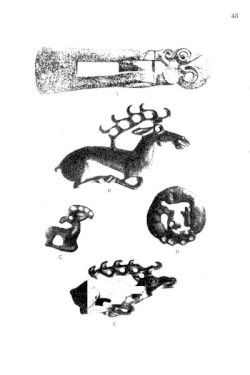
It is a unique contradiction that is here embodied; a conjunction of rigorous stylization with the highest verisimilitude. But this very contradiction is typical of the whole of Scythian art, and not of Scythian art in the narrow sense only, but of the approximately contemporary art of Siberia and even of the Kama region in North-east Russia. We can at once confirm this statement by the remark that in the later Bronze Age of Siberia, which cannot be very far removed in time from the Scythian period, bronze plaques with precisely the same figures are very common. Only here curiously enough the motive often appears in forms already degenerate. Frequently the legs are no longer separated but are depicted as running into one another, so that a sort of long rod seems to lie under the body; however, a transverse dent on this rod betrays the original position of the legs underlying the conventionalization (Plate 43 B). At the same time the correct treatment and the characteristic position of the legs are also found as our illustrations show (Plate 43 E). The reader can see that all the peculiarities of the motive are preserved.
(33/34)
Even the presentation of the antlers with spiral or hooked branches is the same. We find a very similar representation of the antlers on the Siberian bronze mirror in the Hermitage (Plate 41 [Ůž. Ūŗ ŮŗťÚŚ ›ūžŤÚŗśŗ]). Identical bronze plaques representing stags are said to have been found in the Kama district, yet it is uncertain, even if the reports be reliable, whether these were not Siberian imports. In other cases we shall meet plenty of evidence for the identity of this artistic province with the Siberian and the Scythian in the form of unmistakably local products.
It is important to note that, especially in Siberia, the so-called stag figures often allow us to perceive that the animal represented is not a stag but an elk. The conformation of the heavy drooping muzzle leaves no room for doubt on this point. The elk is very plainly depicted on the beautiful wooden plate from the Altai region now in the Hermitage (Plate 59 [√› »Ū‚.Ļ1122/11]). The peculiarities of this animal are characteristically reproduced in the heavy muzzle, the broad palm antlers and the exaggeratedly long limbs.
Besides this motive of the crouching stag or elk with outstretched head we meet manifold variants upon similar representations of the same animals. More rarely other animals, particularly the wild goat, are depicted in the same attitude.
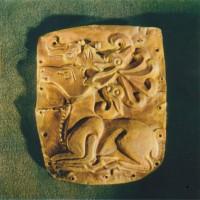
The stag frequently appears in Scythia in a very similar pose, but with the head erect. The limbs are folded beneath the body as before, but the antlers are rather differently treated (Plate 3 B&F). They spread out more widely and the hinder branches are longer and fill up the whole angle between the figureís neck and back. We clearly see the effort to comprehend the whole subject in a compact outline with a view to decorative effect. That striving after a decorative compactness in the motive is also characteristic of Scythian art. On the plaque from Kara-Merket in the Crimea (Plate 3 B), we observe that the two first
(34/35)
and the last antler-branches have been transformed into the heads of birds with hooked beaks in just such a decorative fashion. In the case of the front branches these birdsí heads are turned topsy-turvy; the third is pointing straight down on to the stagís back. The animal is depicted in a similar way with the head upraised rather than stretched out on some of the Siberian bronze plaques (Plate 43 B).
The motive of the same animal in a like pose but with the head turned back over the shoulder is also very common in Scythia. Two variants may be distinguished. In one the head is turned half round so that it comes to lie along the line of the spine and nestles into the back just as the feet are tucked up tightly against the belly. Alternatively the animal has twisted his head round in the plane of his body and rested it sideways against his flank so that the head falls within the outlines of the frame. Both postures are equally natural and can be observed in nature. In the first variant the elk often figures on gold plaques. The head is most clearly portrayed on the plaque purchased at Maikop in the Kuban district (Plate 3 C). The most extreme contortion of the neck is shown on a plaque from Solokha, a grave in the Dniepr region (Plate 3 G); on it, the muzzle is nestling in the hollow of the back. The most conventional treatment is seen on the plaque from a tomb in the Kuban delta (Plate 3 H). In all these cases ó only one example of each type is reproduced on the plate ó the composition remains quite uniform. The antlers, too, are always represented in precisely the same manner curiously shortened. From the forehead rises a bent rod, following the contour of the head and terminating in a birdís head, again inverted, the beak of which reproduces the spirals of the antler-branches.
The wild goat is treated in just the same way in the districts
(35/36)
of the Kuban, Don and Dniepr. His horn is not bent over the head to the back but follows the arch of the neck in quite a natural position (Plate 3 D).
The same motive is also repeated in bronze. The bronze plaque from the Kiev Government (Plate 4 B), the bottom of which ends in a figure, half the paw of a beast of prey and half the talon of a bird, is surmounted by an elk with its heavy muzzle and short but palm-shaped antlers clearly marked. Stylization has advanced further on a plaque from one of the so-called Graves of the Seven Brothers in the Kuban delta (Plate 4 C). Here the elkís muzzle is still distinctly recognizable, although it is very much elongated. The antlers, too, are characteristically broad. But they spread out decoratively in two symmetrical divisions as if viewed full-face, and tower high above the head.
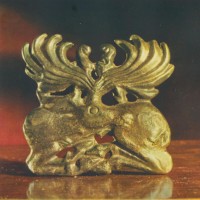
On other plaques from the same grave we meet the second variant of the motive. The stagís head is laid sideways along his flank so as to cover the whole body as far as the hind-quarters (Plate 4 A), the antlers once more spread out decoratively over the head in two symmetrical divisions, in one plane.
In all these examples, parallels to which might be quoted from Siberia (Plate 44 C), we meet the same characteristics: the motive is curiously and regularly stylized; at the same time the representations are always thoroughly alive and true to nature; the appreciation of the forms of the animal world is deep and highly developed.
Let us next examine the representation of a standing stag with his head turned back on a gold plaque in the collection of the Moscow Historical Museum (Plate 3 A). How natural is the headís pose! how truly is the grace of body, muzzle and ear reproduced! And yet a hornless elkís head is attached, purely ornamentally, to the shoulder! The most characteristic
(36/37)
feature is, however, the position of the legs. How well all the lightness and agility of the beast is thereby expressed. If we look closer, we note that the hoofs are not really depicted as standing on the ground but with the toes turned down. We get the impression that the legs are hanging down loose. This is no accident; there are other examples, too, even from Scythia, and it recurs in more marked form in Siberia on the bronze mirror in the Hermitage collection (Plate 41). All the stags or elks and the goat there depicted are floating with hanging legs as if suspended in mid air. Note, too, that the ground is not indicated; the figures are completely cut away from all environment. The artist has reproduced with the most lifelike accuracy and the strongest emphasis on characteristic traits the impression gained from immediate observation of the animals. Abstracted from all context, without any association with ideal constructions, alone and isolated, the fresh living impression, the memory-picture, has served as the artistís model. We might be tempted to speak of a primitive impressionism, but that we are dealing at the same time with such a markedly decorative stylization.
In addition to figures of complete animal forms, motives based upon individual parts of the body, especially the head, were much in vogue. Deerís and elkís heads are also used as independent motives. The impulse to decorative stylization is still more marked in such partial representations.
We have already met the elkís head in profile as an independent ornament upon a figure of a stag. It appears also quite by itself. It is always very much stylized. The pendancy of the muzzle is emphasized in an exaggerated way. Occasionally the outlines of the muzzle in front nearly form a right angle, as happens particularly in objects from the Dniepr district, both of bronze
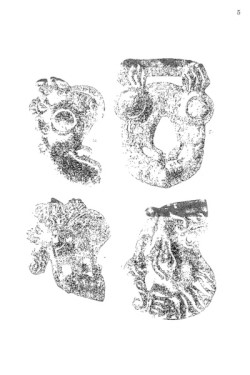
(37/38)
and of carved bone (Plates 5 A&C and 32 E). The contours are more rounded on plaques from the Crimea and the Kuban delta (Plate 5 B). But, en revanche, the jowl droops antlers are extraordinarily stylized. Two branches in the shape of birdsí heads sprout out on either side of the forehead over the eyes. The birdsí heads are once more inverted so that their beaks may form the proper volutes. Between them grows a palmette, while on Fig. A another grows between the ear and the nape of the neck. This is a clear instance of the penetration of Scythian culture by Greek elements. Typically local on the other hand are the volute-shaped mouldings, often encircling the mouth and nostrils (Plates 5 B&C). They recur in a very similar way in Siberia on a double figure of elksí heads in carved bone (Plate 60 C). Such reduplication of the motive is also met in Scythia. A fine example is the bronze plaque from the Dniepr district (Plate 5 D), which, like the Siberian specimen in bone, served as a clasp. Two elksí heads in strict profile, with but one eye and one ear each, are here opposed with the muzzles and necks touching. A strip of bronze purely utilitarian in purpose unites the ears above the heads. On the bronze specimen from Siberia as on some representations of single elkís heads the eye, too, is made unnaturally big and stands out as a round boss with a flanged edge right on the outline of the head. The stylization of the ear is also characteristic; in almost all cases the hair on the inside is suggested by parallel lines (Plates 5 A, C & D). In one of these elksí heads the thick mane of the neck provides an effective border for the outline behind.
We see that the elk constituted a clearly marked, independent and fairly widely diffused motive even in Scythia. To show that the same motive was current in the third artistic province
(38/39)
ó North-east Russia ó we may refer to the exquisite carving in bone which was found in that region and is certainly a local product (Plate 64 F).
Beside the elkís head the motive of the stagís head lived its own independent life. It is characteristic of it that the antlers are fruitfully used for decorative ends. In the simpler figures the antlers generally tower over the head. They are represented thus on a series of bronze stagsí heads from various graves in the two adjacent groups of barrows known as the Great and Small Seven Brothers in the Kuban district (Plate 6 B, C & D). Here, too, some branches are frequently not naturalistic, but shaped decoratively into the form of birdsí heads (Plate 6 A). In such decorative stylization the antlers of the stagís head on the side plate of a gold sword-sheath from a grave at the mouth of the Don are represented in an exaggerated and already rather degenerate fashion (Plate 22 B). Here extended birdsí heads in an endless row perch as branches on the antler, which ultimately terminates in a half Greek, half Oriental palmette. This motive of the stagís antlers with birdsí heads also appears quite by itself and in fact without any indication of the head on late and degenerate products. How fruitfully the motive of the stagís antlers was used for decorative purposes is shown by the illustrations on Plate 7, all bronzes from the Kuban district. In the middle of the girdle-plate the forequarter of a stag ó head, foreleg, and antlers ó is represented (Plate 7 A). The antlers are spread out in some incomprehensible way into two symmetrical halves, each branch being a very long drawn out birdís head. To left and right lie stagsí heads. That on the left is preserved whole; on the right, the head itself has been broken off and only the antlers, formed as on the other side, have survived. The antlers are again divided
(39/40)
each pair into two symmetrical halves, each one consisting of three birdsí heads, of which the middle one projects furthest. The birds on either antler are facing in opposite directions. The several corresponding birdsí heads vary considerably in size. In a like manner, nearly the whole of the object on the plate decorating the bridle-piece is framed by the antlers of two stags, heraldically opposed, with the heads turned backwards (Plate 7 C).
In these specimens, however freely the antlers are used for decorative ends, they are still understood more or less for what they are. But in the next two examples they are wholly dissolved into a purely ornamental scheme. On the plate adorning another bit from the same find in the Kuban district (Plate 7 B), the stagís head is still quite clear, with its extended ear, its eye and its firm set muzzle. The antlers have, however, become a mere ornament, and in the midst of their decoratively interlacing lines appears a sort of inverted Greek palmette. On the poletop from the Kuban district the meaning of the motive has already been entirely forgotten. Of the stagís head, only a thoroughly degenerate ear and the tip of the muzzle survive, the eye has disappeared and the antlers have grown into a senseless medley of volutes (Plate 7 D). These are good examples for showing how in this art province the organic animal form is the original element; the purely ornamental or vegetable shapes are secondary and generally first arise out of the degeneration of animal forms.
In the whole domain of the Scytho-Siberian animal style the birdís head motive is perhaps even more widespread than the stagís or elkís head. We have already encountered it several times ornamenting antlers. But it is also very common as an independent motive. It is most definitely elaborated on the
(40/41)
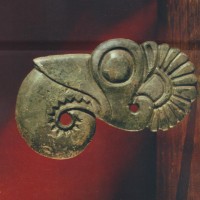
magnificent bronze plaque from one of the Seven Brothers (Plate 8 A). The palmette at the back is again naturally to be ascribed to Greek influence. On the other examples on this plate too the characteristic features of this motive are well marked, Perhaps the purest is the specifically Scythian stylization on the beautiful bronze bridle-piece from the Kuban district (Plate 8 D). The hooked beak rolled into a regular scroll is exaggeratedly big. In front of the eye the cere at the base of the nose is clearly marked and has been deliberately emphasized for decorative effect. The cere and the hooked beak are characteristic marks of birds of prey and at the same time typical features of the Scytho-Siberian stylization. Thus on this motive too we recognize the same quality: the artist selects the characteristic features of the animal form as he has observed them in nature, restricting himself most rigidly to the absolutely essential elements, uses these as the basis of a representation, and then works it up as an independent element in decorative fashion.
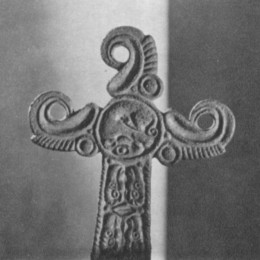
The reader will notice how repeatedly this emphasis on the cere recurs everywhere, both in Scythia and in Siberia and the Kama district. The birdsí heads on the dagger-hilts from Siberia (Plate 40), the similar birdís head on a bronze from the Kama district (Plate 64 E), and all the specimens from Scythia reproduced here exhibit the same peculiarity in different variants. This feature is especially marked on the cruciform bronze girdle-plate found in the necropolis of Olbia (Plate 9). It reappears again on the bone comb from Poltava Government, here indeed repeated twice on the same head (Plate 33 A). The birdís head motive is also common in gold work; examples are collected on Plate 11. Four birdsí heads are perched in a row on a vase handle from the Solokha grave (Plate 11 H). In the case of another vase handle, also of typically Scythian
(41/42)
form, the whole object is wrought into the form of a birdís head (Plate 11 G). At the back of the head perches another smaller birdís head, the scroll of whose beak passed over into the eye of the larger bird, making the whole a regular puzzlepicture. The motive is also wrought in iron, most commonly on sword-hilts (Plate 10 A), but also on bridle-pieces (Plate 10 B). The head on the iron knife from Kiev Government illustrated on the same plate is peculiar (Plate 11 C). The outlines are those of an elkís head, but the long slit for the mouth and the cere below the eyes are traits belonging to the birdís head. It is a combination of two originally distinct motives.
We possess two masterpieces of Scythian decorative art devoted to the birdís head motive. Both are equally perfect, although the one is a veritable miniature while the other is on a monumental scale. The first of these is a piece of bone carving found near Kerch. The whole object, here reproduced in its natural size, represents plastically a birdís head (Plate 32 A). At the back a little beast like a hare with the legs curiously tucked up has been carved. This animalís tail is long drawn out, passes along under the rear edge of the birdís head, then turns up and forms the beakís cere in the guise of the forequarters of a second hare. In the place of the nostril holes on the beak yet another little animalís head has been carved, and its long ear in the form of a double ridge follows the contour of the beak. The ingenuity displayed in the invention and execution of such a complicated little scene fills us with amazement.
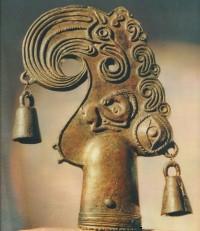
The second masterpiece is a pair of bronze pole-tops in the form of birdsí heads from Ulski Aul in the Kuban district (Plates 24 and 25 [Ůž. Ūŗ ŮŗťÚŚ ›ūžŤÚŗśŗ: »Ū‚. ĻĻ ů.1909-1/111 Ť ů.1909-1/112]). The one is almost smooth, the surface of the other is richly decorated. The pure contours of the head are admirable, the great pointed scroll of the beak contrasting with
(42/43)
the sharp edge of the long prominent cere below the base of which the great eye stands out in relief right in the corner of the figure. Along the projecting fold of the cere, smaller birdsí heads have been represented by parallel lines in relief. On the more elaborately decorated specimen the scroll of the beak has also been adorned with such parallel lines in relief. In the middle of this figure yet another birdís head has been depicted facing the opposite way. Below it, the figure of a wild goat in the already familiar attitude, with head turned back and legs tucked up, has been moulded in relief. Little bells were once suspended from the now partly broken loops at the edge. These two pole-tops are among the finest achievements of Scythian art in the decorative treatment of organic bodily forms.
A feline beast of prey plays a prominent role in Scythian art. The representation of this animal must be attributed to southern influence since neither the panther nor the lion is native to southern Russia. It is, however, characteristic that occasionally even in Scythia, but more especially in north-east Russia and Siberia, other animals, among which the bear, an animal as much at home in those wooded regions as the elk, distinctly recognizable appear as the basis of the very same motives which in Scythia are based upon our feline beast. There are three chief motives derived from this beast.
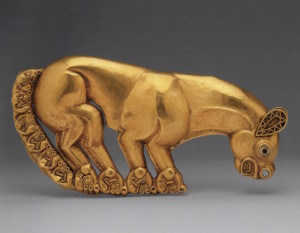
The first is as beautifully and brilliantly represented by the shield blazon enriched with coloured inlays of glass paste and amber as is the stag on a similar emblem from Kostromskaya Stanitsa. It is a gem from the rich treasure of Kelermeskaya Stanitsa, likewise in the Kuban district (Plate 12). The cat-like beastís legs slant forward and his head hangs down in front of his paws.
This motive is common on gold plaques (Plate 11 D). Both
(43/44)
borders of the gorytus-plate depicting stags are occupied byrepetitions of this motive (Plate 2), and a column of similar beasts adorns the gold plate covering a sword-sheath (Plate 23 A). The gold plaques from Kharkov Government in the Moscow Historical Museum are very similar (Plate 11 A). But here the position of the legs is rather different: the feet are drawn up closer to the body; the paws and the bush of the tail have grown into birdsí heads; a small birdís head perches on the beastís lower jaw and a larger one decorates his shoulder.
The beasts often adorning the handles of the graceful Siberian knives sometimes assume a very similar attitude. These animals are generally depicted as boars, but bears, too, can often be distinctly recognized, and this motive was probably the original one (Plate 39 A & B). The little bear engraved on the elkís head from North-east Russia evidently belongs to this family (Plate 64 F). The characteristic pose of the head is precisely the same and is just as proper to a bear as is the outstretched position to elks and stags. So we may reasonably assume that the whole motive had been originally inspired by a bear.
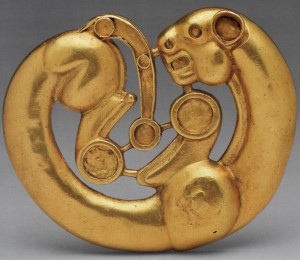
On each paw of the great beast from Kelermeskaya a little doubled-up beast is depicted. The same figure is repeated six times on the surface of the great beastís tail (Plate 12). It is the second motive to be discussed. Here it is not as clear and comprehensible as elsewhere. It comes out most simply and distinctly on the exquisite gold plaque from Siberia in the Hermitage collection (Plate 45). The beast is curled up into a complete circle. The head hangs down from the long arched neck and almost reaches the tail. The shoulder is powerful and stands out like a great boss. From it the foreleg is extended in an arc concentric with the curve of the neck. The whole body, too, is drawn out and bent into a semicircle. The hind-quarter
(44/45)
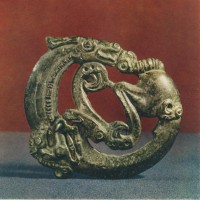
stands out as strongly as the shoulder and thence the hind leg is extended towards the inner curve of the belly. The tail is bent round into the middle of the figure between the rump and the nose; often, however, it occupies only a little space between the rump and the jowl. It is an unique motive and very conventionally treated. But incomprehensible though it be at first sight, it was none the less very popular. In smaller, often rather degenerate, representations it is common in Siberia and the Kama district as well as in Scythia (Plates 14 C&D, 43 D and 64 D). It is to be remarked that it also appears oh carved bone (Plate 32 B&C), when the rendering of the eyes, nostrils and paws as circles closely resembles what we saw on the gold plaque from Siberia. Perhaps the most beautiful example of this motive is the great bronze plaque from a grave near Simferopol in the Crimea (Plate 13 [√› »Ū‚.Ļ ū.1895-10/2.]). Only the beastís head is here rather different. It has an elongated, relatively pointed nose as is often the case with this theme (cf. Plate 14 D). The paws take the form of birdsí heads and the figure of the wild goat with reverted head is again depicted in relief on the shoulder. Below it a very stylized elkís head has been added to the fore-paw. The horn of the wild goat and the feline beastís tail also terminate in birdsí heads.
This motive is again very well represented by the bronze button from one of the Seven Brothers (Plate 14 B). Here it is obviously a lion that is intended. The mane is conventionally rendered by long parallel strokes on the neck; the shoulder is free of hair. But then the rest of the body to the hind-quarters is again decorated with radial strokes. We are in doubt whether they are meant to indicate mane or ribs. In any case the Way that the shoulder and the hind-quarters stand out is typical.
With slight modification in the position of the legs the
(45/46)
same motive recurs in the circle in the middle of the cruciform plaque from Olbia (Plate 9). It reappears, quite regular in composition if a little degenerate, in the Ananyino culture of North-east Russia (Plate 64 D), and in other probably contemporary remains.
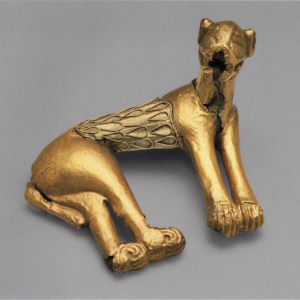
The peculiarities of the third motive are as follows: the body of the beast which is represented sometimes reclining, sometimes standing, is depicted in relief side face. The beastís neck and head are plastically turned forward to face the spectator. The finest specimen of this motive is a panther figure of solid bronze overlaid with gold-foil from the so-called Golden Barrow near Simferopol in the Crimea (Plate 15 A). The beastís body had been adorned with coloured inlays but leaving the shoulders and hind-quarters plain; but only the leaf-shaped cells that received the inlays remain. Two bronze figures from the Dniepr district also exemplify this motive (Plates 15 , B&C), In both specimens the tail is depicted in the guise of a birdís head. It is to be noted that in a grave near Voronezh on the upper Don a silver reproduction of the same motive was found which obviously represented a bear. From the Altai in Siberia comes the carved wooden figure of an ungulate animal which is represented in precisely the same attitude (Plate 63 B). Thus in these three motives we can once more observe the identity of artistic style in Scythia, north-east Russia and Siberia.
That can be as definitely proved with the aid of the motive derived from the head of a beast of prey. The independent representation of a lionís or pantherís head occurs relatively often in Scythia. The gaping maw discloses the powerful incisor fangs. The whiskers on the upper lip are seldom overlooked. In Scythia the motive is found both in bronze (Plate 16), and on a sadly damaged piece of carved bone in the Moscow
(46/47)
Historical Museum. On the other hand, we possess an exquisite specimen from Siberia. It is a wooden plaque from the Altai in the Hermitage (Plate 60 G). The stylistic treatment is admirable with scroll lines round the ear and lower jaw. Cunning is livelily expressed in the oblique eye, and the structure of the maw of a ravening beast with the two great incisor fangs in front and the smaller molars arrayed behind them is happily reproduced. The stylized rendering of the whiskers on the upper lip is also very marked here; they are indicated by parallel curved incisions. Although we have no such marked instance of this feature on purely Scythian objects from south Russia, we must ascribe this whisker-motive to western influence since it is typical of the representation of the lionís jowl in ancient Anatolian art whence it was taken over by archaic Greek art.
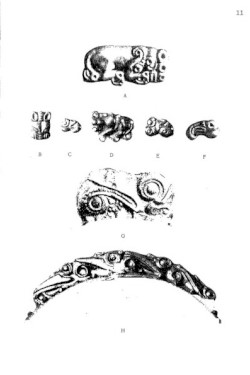
The lionís or pantherís head viewed full face is another comparatively common motive. In Scythia, in addition to small, much stylized representations like that on the gold plaque here illustrated (Plate 11 B), larger examples are also available. The whiskers are, however, very strongly marked on the gold plaque. This motive reappears in much the same form in Siberia (Plate 60 F), and also in the Kama district (Plate 64 C). Then we meet it again on a larger scale but still transformed by extreme stylization in horn and wood-carvings from the Altai (Plate 60 D and 62 [√»Ő ĻőÔ.Ń 1803/64]). We shall have occasion to return to these representations later on.
Besides the panthersí or lionsí heads we also meet isolated representations of that sharp-nosed head which we saw on some of the animals curled up into a circle. Two examples are shown here from Scythia where this motive is relatively rare (Plate 17 A&B). Characteristic is the long pointed jowl with open maw. Behind the eye stands an ear; it is generally small but on the
(47/48)
second of the heads already manifests a tendency towards decorative extension. The weird effect of the other head is enhanced by the representation of a bird's head on the cheek-bone. In fact, it is hard to say what animal is actually intended; we are evidently confronted with a very highly stylized motive. However, on the exquisite bone spoon from a grave in Orenburg Government, it is unmistakably a bear that is depicted with such a head (Plate 31 A). The outlines of the great unwieldy body with its broad, powerful limbs, are engraved on the back of the spoon with admirable certainty. Framed within the contours of the bearís body another elongated beast is curled up with a similar pointed head and a long ear. The bearís head projects far forward and is carved to form the handle of the spoon. Unfortunately the upper edge of the head has been broken off so that the snout looks more pointed than it originally was. We must complete the picture with a distinct, probably scrollshaped, representation of the nostrils as other examples of the same head show. Nevertheless, it is clear that we are dealing with the same motive which here is evidently intended to represent a bearís head. The conformation of the beastís jaws with two long incisor fangs in front and half-rounded teeth behind them is here typical.
This trait is preserved in another bone carving from Orenburg Government (Plate 31 B), and in the bronze examples from Scythia (Plate 17 A&B), which have already been further transformed by stylization. For comparison, let us look again at the little figure of a bear engraved on the elkís head from North-east Russia (Plate 64 F). The outline of the whole beast is here much more cursorily sketched; still the bearís head exhibits an unmistakable similarity to the motive just discussed. The ďbearsĒ again on the bronze Siberian knives (Plate 39
(48/49)
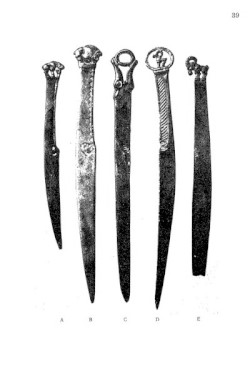
A&B) have very similar heads. So we may well assume, despite the astonishment provoked by such a hypothesis, that this peculiar motive is based upon a representation of the bear. Of course, this motive is very far from its original condition and exhibits a constant tendency to contamination with other motives or to purely ornamental stylization. In Siberia it very often happens that the snout is drawn out to a sharp point and comes to resemble a wolfís head, as for instance in the case of the double figure on a bronze mirror-handle (Plate 44 A).
Occasionally whiskers are seen on the upper lip and recall the pantherís or lionís head. We find this in Scythia on one of the bronze heads (Plate 17 A), and also in a wood-carving from the Altai (Plate 60 A). On the latter the volute into which the nostril has been transformed is very typical; on the second bronze head from Scythia the nostril is represented in a similar way (Plate 17 B). On the two heads adorning the guard of a Siberian dagger (in the Hermitage), with iron hilt and bronze blade ó an unusual combination ó the nostrils are in each case represented as scrolls (Plate 40 B). And we meet the motive characterized by precisely the same peculiarity in North-east Russia. Particularly satisfying is the representation on the bronze axe (Plate 64 A). But just the same traits are exhibited on a little bronze plaque (Plate 64 B), depicting this head twice, but this time the lower jaw is omitted in each case so that we get two heads with two eyes and two nostrils, but only one mouth.
We have dwelt at some length on this motive because in itself it is rather incomprehensible and at the same time because it is of importance in connection with the influence exerted by the Scytho-Siberian repertoire upon other cultures, as we shall later see. In Scythia it played a comparatively small part and was soon misunderstood. That is natural since the bear, a forest
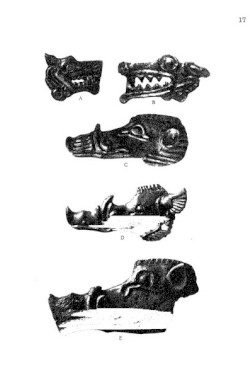
(49/50)
animal, is not met on the steppe, so that the artist lost immediate contact with his model. It is not, therefore, surprising that in Scythia boarsí heads appear as well in outlines that recall this motive (Plate 17 C, D, E). In Siberia, too, as we have already seen, the bearís figure when no longer properly understood turned into a boar. However, the boar was an animal known also to Greek artists, and it is possible that they have contributed to the transformation of the motive.
To complete our survey of the motives of the Scythian animal style several examples of two further motives are grouped together on the next plates (Plates 18 and 19). They were fruitfully employed on horse-trappings for the decoration of frontlets and cheek-pieces. They appear also on other objects, but not so often. These motives are derived from animalsí feet. The representations of a hoof with the adjacent fetlock joint are admirable and in perfect harmony with the best qualities of the animal style. The feeling for the organic structure of the animal body fills us with admiration. The figure is clearest on the bridle-piece, terminating in two opposing hoofs (Plate 18 C). On the joint, the delicacy and mobility of which are admirably rendered, the short fetlock is indicated. Below comes the pastern and right at the end is set the hoof, sharply outlined and gracefully shaped. These three parts are always carefully distinguished, however stylized the figure may be. Consider now the small dagger-like object surmounted by a pantherís head (Plate 18 A). On the back it is provided with a strap-hole so that it must have been a horse ornament, very likely a frontlet. Here the hoof is very long drawn out and ends in a regular point. The third example, likewise a horseís frontlet, is yet more stylized (Plate 18 B). The representation on the upper part of the object is obscure; only the little Greek palmette is plain. The lower
(50/51)
part once more forms a hoof. The fetlock joint is here distorted, but its elongated form is only an exaggeration of what is given in nature. The fetlock is duplicated and hangs down right to the hoof.
An instructive evolutionary series is provided by the motive of the separated hind legs of a leonine beast of prey. We meet it quite clearly marked both in the representation of the complete hind-quarters with both legs (Plate 19 A&C), and that of one leg alone. In addition, highly stylized examples occur such as that illustrated on the top of the plate to the right (Plate 19 B). The feet are no longer the paws of a savage beast but plainly the birdís talons. The rear claw is turned the opposite way to the rest, which is natural on birdsí legs but is impossible in the case of paws. We have already observed such hybridization between two motives, and this particular case we might illustrate by the example depicted beneath a reclining elk (Plate 4 B). Here, too, belongs the figure under one of the feline beasts facing the spectator (Plate 15 C); this time it is obviously a birdís claw. The last example (Plate 19 D) shows how this motive, like that of the stagsí antlers, can be resolved into a mere ornament.
The repertoire of Scythian art is not, of course, exhausted with the examples that we have cited. But they will have been sufficient to serve as an introduction to the comprehension of this remarkable style. The exceptional faculty for naturalistic reproduction of animal forms has been amply illustrated and at the same time all the figures bear witness to a great talent for decorative stylization. These two tendencies are mutually interwoven, and, however contradictory their nature may seem, are combined to an organic unity in this style which endows all its creations with a high artistic merit. Of course, a certain amount of habituation is needed for an insight into the strangely stylized
(51/52)
figures. Nevertheless, the more they are studied, the more impressive they appear. The whole fancifulness of this style is at bottom only apparent. All the curious combinations of various animal forms in a single figure are far from being so fantastic as they seem at first sight. Generally we only find that individual parts of animals, above all parts important for the organic structure of the frame, have been ornamented with figures of other animal forms. In this way joints or shoulderblades are especially often emphasized, or the individual branches of the antlers marked off from the rest. In representations of heads it is often the cheek-bone that is thus adorned. This procedure is therefore only a way of emphasizing such parts of the body as are constructively significant for the total presentation.
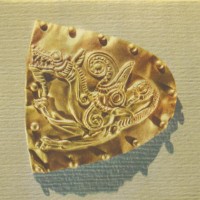
Such fantastic hybrids as the two monsters on Plate 20 are rare. Below we see a lion with stagís antlers, the branches of which are represented by birdsí heads (Plate 20 B). The gold plaque illustrated above it (Plate 20 A) presents a figure composed of several heterogeneous elements and betrays obviously foreign influence to an unusual degree. The monsterís back ends in a purely Greek swanís or gooseís head, which shows us that we have to deal most likely with the work of a Greek craftsman imitating Scythian style. The paws of the monster belong to a lion, its head strongly recalls the motive of the Scythian ďbearsí heads,Ē but stands half-way between that of a Greek sea-horse and a Chinese dragon; its wing, again, has the form of a Scythian birdís head, with very prominent cere and a pointed ear. We must also ascribe to foreign influence, this time Assyrian or Anatolian, though perhaps transmitted through Greece, the scorpion-like cartilaginous tail of the lion on the plate decorating a scabbard (Plate 22 A). The fabulous beast on another scabbard from the Don delta (Plate 22 B), is half
(52/53)
made up of the specifically Greek winged griffin with lionís paws and birdís beak. It is not quite clear whence came the other elements of the figure ó the extraordinarily wide fishís tail and the snake whose head the griffin is biting; they are not Scythian, at least, in such a composition.
As we have said, such really fantastic figures are the exception in Scythian art. The latter gives the impression of being fantastic rather because we are dealing not with a realistic and naturalistic style, the repertoire of which is inspired by logical rigorous observation, but with a style that is best described as impressionistic.
The peculiar direction taken by this style is perhaps most clearly revealed in the striking circumstance that the Scytho-Siberian animal style exhibits an inexplicable but far-reaching affinity with the Minoan-Mycenæan. Nearly all its motives recur in Minoan-Mycenæan art. The French savant, Salomon Reinach, was the first to call attention to this resemblance in his interesting article on the representation of the gallop in the art of ancient and modern peoples. He shows that the figure of the so-called ďflying gallop,Ē in which the animal is represented stretched out with its forelegs extended in a line with the body and its hind legs thrown back correspondingly, is at once characteristic of Minoan-Mycenæan art and foreign to that of all other ancient and modern peoples; it only recurs in Scythia, Siberia and the Far East. He further points out that this motive is not true to life but nevertheless reproduces in a most effective manner the impression of swift movement. Now to reproduce the immediate sense impression, not accurately but in a lively and lifelike way, was the very aim of Scythian art. Unfortunately it has not been possible to illustrate this motive here. But the same feature is clearly marked in another motive. Let us
(53/54)
examine the Siberian gold and bronze plaques depicting scenes of fighting animals (e.g. Plates 46, 47 and 55 C). How often are the animals depicted with the body so twisted that the forequarters are turned downwards, while the hind-quarters are turned upwards! Can the agonized writhings of a wounded beast or the fury of his assailant be more simply rendered? And yet the motive is as conventional as one could wish. Indeed, it is often used apart from all context in individual figures. An instance is seen in the bronze bit from one grave in the Seven Brothers which has been fashioned in the form of a lion twisted in this way (Plate 14 A).
Other motives of the animal style, too, reappear in Minoan and Mycenæan art. We may cite the animals with hanging legs and those which are curled almost into a circle. Conversely the standard motive of the Minoan-Mycenæan lion, often represented in the Aegean with reverted head, reappears again in Scythian and Siberian art.
How are we to explain this far-reaching kinship in aim between the two artistic schools? It remains on the face of it a riddle. Immediate relations between Minoan-Mycenæan and Scytho-Siberian civilizations are unthinkable; the two are too widely separated in space and time. An interval of some five hundred years separates them. Nor has the least trace of Mycenæan influence on South Russia, either during that civilizationís life or later, yet been discovered. Still, the kinship between the two provinces of art remains striking and typical of both of them. Here as there art unites in itself the highest realism and naturalism of expression with the most rigid decorative stylization.
The exceptional decorative talent of Scythian art is conspicuously illustrated in the great ingenuity which the artist displayed
(54/55)
in filling up a shape determined by practical ends with animal figures so as to leave a minimum of empty space. For this purpose a series of small figures is sometimes grouped together or alternatively the whole object is fashioned in the shape of an animal. So, for instance, the frontlets of bridle-trappings are occasionally shaped like fishes. We have two fine specimens in gold-leaf from the Barrow of Solokha (Plate 21); from Siberia comes an analogous frontlet with only this difference, that one instead of two fishes composes its outline. The two wing-like pieces belonging to the same bridle are shown by the parallel flutings to represent earsó compare the stagsí and elksí heads.
In the same way handles are often fashioned as figures of animals, as for instance the handles of a gold vase from Siberia (Plate 58), or the handles of the huge Scythian bronze cauldrons. On the specimen from Kelermes (Plate 29), here illustrated, where only one of the two handles has survived, it is a joy to see how well the stylized horn of the wild goat is adapted to the practical function of the ornament. In fact, this figure is a standard type as the handles of the bronze mirror and a bellshaped object from Siberia show (Plate 44 B&C). In like fashion the round nob-handles affixed to rods in the middle of the circular bronze mirrors are often decorated with animal forms. On the mirror from the Samokvasov collection in Moscow (Plate 30 2), it is once more the reclining wild goat with reverted head and tucked up legs that forms the handle.
The gold plates from sword-sheaths here illustrated are excellent examples of this skill in filling up a given object with animal figures. How perfectly the contours of the two wild goats on the upper part of the scabbard from Poltava Government (Plate 23 A) fit the form of the enlargement that receives the swordís guards! How completely the device at the side of the
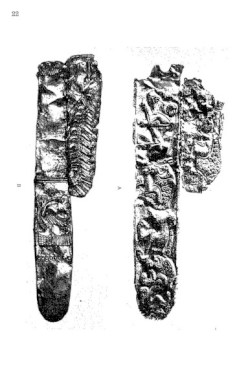
(55/56)
sheath proper that serves to attach it to the sword-belt is covered over by the stagís head and its antlers on the gold plate from the Don delta (Plate 22 B). How admirably the twisted hindquarters of a lion have been adapted to the lower edge of the plate covering a sheath from the Don district (Plate 23 A). The lionís figure has been no less skillfully adjusted to the shape of the two projections at the side of the scabbard-plate from Solokha (Plate 23 B). Similar lions grasping deersí heads in their forepaws occupy the two upper fields on the sheath; below them come two motives inspired by Greek influence ó the griffin with reverted head and notched mane but no wings, and the panther whose head is turned round to face the spectator quite in the typical manner of archaic Greek art. Finally, the round chape is entirely taken up by a lionís head, viewed full face, which is frankly degenerate. The upper half of the circle is occupied by the ears with characteristic parallel flutings and the fretted mane between them, the lower half beneath the eyes by the upper lip with the whiskers in the same stylized rendering as the ear-hair.
In this connection the ornamentation of the upper rims of sword-sheaths, generally with two birdsí heads, is very instructive. The unfortunately damaged heads are reconstructed on the plate as a scene of lions and a boar; from the Don district (Plate 22 A). In this position, with the top of the head downwards, and the curving lines of the beaks sweeping upwards from either side to meet in the centre, they reproduce the outline of the heart-shaped guards of the sword-hilt. On the scabbard from Solokha (Plate 23 B), the position of the heads is again correct, but they are themselves very sketchily rendered and almost misunderstood: the eyes are turning into rosettes. The birdsí heads on the other scabbard from the Don (Plate 22 B)
(56/57)
are better shaped, but here they are wrongly placed with the top of the head upwards. The whole point of decoration with this motive is thus really lost thereby. The Greek palmette under the beaks gives us a hint of how this mistake arose. We noticed previously that the monster at the bottom of this sheath was also half Greek. It was then no Scyth but a Greek craftsman living in Scythia who fashioned this object. His familiarity with Scythian art was great, but yet it is clear that his genius was alien to the eminently decorative capacity of the latter art.
However, the finest results in filling up a functionally determined shape with animal forms were perhaps achieved by Siberian art. Almost every specimen provides convincing proof of this statement. Different as the scene is in every case, the shape remains perfectly uniform in a series of gold or bronze plaques with rounded outline and one end always narrower than the other (Plates 46-51). Unfortunately it is impossible to determine the precise purpose of such a shape, but most likely the plaques were belt-clasps. They were almost invariably manufactured in pairs. Almost without exception both copies have been preserved of all the plaques in the Hermitage collection. They always correspond; that is to say, one piece is the inverse of the other. It is not quite clear how they should be combined. On the broader end a spike often projects obliquely outwards. Still a single plaque with a duplicated scene of a combat between a tiger and a camel would seem to prove that such plaques must have been joined with the narrower ends in contact. For on this double representation, which otherwise corresponds exactly to the complete repetition of the motive on other plaques (Plate 49 B), the two animal figures have grown together so that they have no hind legs, and one animal
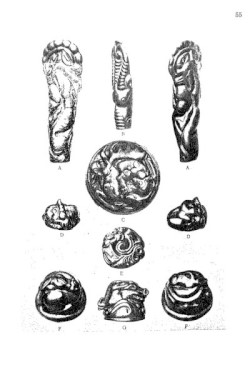
(57/58)
results, with two heads facing right and left respectively and four forelegs.
In any case the form of the plaques itself is always retained, however much the scenes depicted on them may vary. Therein the artist displays great decorative ingenuity. The little articles figured on Plate 55 are absolute masterpieces of decorative invention. The battle between a wolf and a wild goat on the long object (Plate 55 A), the upper outline of which is formed by the goatís horn, is most realistically rendered, despite the extreme compression of the motive and the violent contortion of the animalsí bodies. The elk and the tiger (or panther) fill up the whole round surface of a gold button (Plate 55 C). How skillfully the motive of the twisted body is used here! Or examine the nob-shaped buttons, at the bottom of the plate (Plate 55 F&G), on which the animals themselves are coiled up into the form of the nob in such a way that the head lies in the middle of the top. And how inimitable is the decorative taste whereby the whole bezels of the two rings are fashioned into animal forms! In the ring from Siberia in the Hermitage Collection it is a reclining goat with reverted head (Plate 55 D); on the other ring (Plate 55 E), that from the treasure of the Oxus, the bezel is composed of a lion in the attitude of the flying gallop, with twisted body (note the oblique line of the spine) and curled up into a circle.
On an equally high level of excellence stands the masterly clasp of the silver girdle from the Kuban district, an imported Siberian product (Plate 46 B). With what incredible dexterity have the splayed hind legs of the mortally wounded horse been adapted to form the right outline to receive the first plate of the attached girdle! At the other end the griffinís back-turned foot and the lower edge of his left wing describe the same contour.
(58/59)
The girdle plates depict birds with outstretched pinions. The birdsí talons are indicated at the inner edge of each wing, while the body and head are wholly filled up with incrustation and have become geometrical ornaments. In perfect harmony with the spirit of the whole motive the griffinís beak embedded in the horseís neck forms the spikes of the clasp. [ŌūŤž. ŮŗťÚŗ: ő Ú.Ū. ęŐŗťÍÓÔŮÍÓž ÔӡٌĽ Ůž. ŮÚŗÚŁĢ ņ.ņ. »ŚŮŮŚŪŗ.]
The high decorative capacity of Scythian art is most effectively displayed in the series of bronze pole-tops (Plates 24-28). These were used in the funeral ritual, and several of the same pattern are almost always found in the same grave. Perhaps they were once fastened like standards to the bier. As the animal style can express itself in tiny miniatures, so here it turns into a monumental decorative mode, we might term it a poster style, full of intense effect and lively, well-nigh startling contours and divisions of the surface.
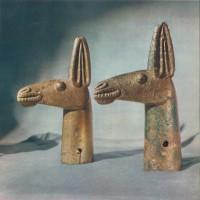
What force is expressed in the beaks of the two pole-tops, shaped as birdsí heads! (Plates 24 and 25). The less ornate specimen is almost the more impressive with its sparing repetition of the same motive. What boldness in the stiff pricked-up ears and the muzzle projecting forwards horizontally of the horseís head! (Plate 26). How splendidly the contours of the griffinís beak harmonize with the bulging shape of the great bell (Plate 27). How startling and yet how suggestive on the stag figure is the maze of lines, almost each of which is resolved into a prolonged, sweeping, pointed ribbon! (Plate 28).
Siberian art also attains the same high plane of massive impressiveness on some of the exquisite gold plaques. What unbridled passion, what pathos, what tensity pervades the battle between lion-griffin and horse, both on the gold plaque and on the silver girdle-clasp! (Plate 46). How solidly impressive is the plaque depicting a struggle between a tiger and a fantastic
(59/60)
creature with the paws of a beast of prey, a head still recognizable as the stylized bear and antlers, the branches of which, like the end of the creatureís tail, are regular birdsí heads (Plate 48). How nobly designed is the group of the yak and the eagle with wide pinions and sweeping tail grasped in the jaws of yet a third long-haired beast (Plate 50). Take the other group of four animals (Plate 51), the eagle, the huge tiger, the little beast and the common prize of the contest, the ungulate beast with reverted birdís head, in the middle. With how intense a passion is the whole scene fused!
The most beautiful of all specimens of this type is, however, the unique torque in the Stroganov collection (Plate 42). It is alleged to have been found in Perm Government. That is possible, but in that case it must have been imported; for it is perhaps the purest product of the Siberian style that we possess. How stupendous is the effect of the two lionsí figures with enormous heads and mighty paws. The two beasts crouch facing one another in wild rage. We almost expect to hear angry roars and savage growls proceed from the grinning jaws, so convincingly lifelike is the delineation. But at the same time the fullest use has again been made of the expansion of the object towards the middle to fill up the widened face of the torque with animal figures. And the conformation of the animals is anything but realistic. On the contrary, they are just made up of a series of immensely simplified, smooth surfaces in sharp relief.
At the same time, this object shows us most clearly the technical roots of the style. This torque has been cast in bronze. But the clear-cut, smoothed surfaces of the moulding bespeak a quite different material medium and a quite different technique. It was patently by carving with the knife in some soft substance,
(60/61)
most probably wood, that the positive for the mould was originally executed. The oblique bevelled line carved from the eye to the corner of the mouth and rounded off below has quite clearly been cut with a knife. The ear with its out-turned lobes, the twisted flutings on the paws, the claws bevelled on both sides, all these features have unmistakably been produced by knife cuts. The abrupt edge of the mane, the deep-furrowed angle above the hind paws, the whole smooth treatment of the surfaces are quite intelligible in such a technique. And how naturally the preference displayed by the animal style in general as well as on this torque for ears terminating in a scroll is explained simply by the habit of carving in wood! Again, the typical stylization of the mouth of a beast of prey with the two incisor fangs in front executed, just like the claws on paws, by two diverging cuts and with the outlines of the back teeth rounded off, is explained as a form natural for carving.
We meet the same treatment of the paws as on the torque again on gold and bronze plaques from Siberia. In the case of tigers, moreover, the stripes are represented by long sweeping furrows running down vertically (e.g. Plate 57 [ž.Š., ŪŗšÓ: 47?]), evidently executed by cuts. Russian peasant-craftsmen model bears out of carved wood in just the same manner to-day. It matters not what example of the animal style we take up, everywhere we find the same technical features underlying the stylization; and that quite irrespective of the material or the technique in which the actual object has been executed. Whether metal objects of bronze, silver, gold or iron be cast in the mould formed by wooden positives or be wrought or stamped into such moulds or finally hammered out free hand, the stylistic treatment is always conceived of in terms of carving. Indeed, the same models are imitated in stone or even in textiles.
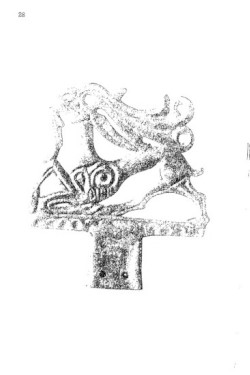
(61/62)
Let us re-examine the cast bronze pole-top depicting a stag (Plate 28). The long ribbons of the antlers with their bevelled edges are quite obviously carved. The same is true of the three distinct tufts of the beard hanging down from the chin to the knee of the uplifted foreleg. The beastís left ear is executed by two cuts of purest notch-carving. And the birdís head on the shoulder-blade is equally plainly fashioned by the same method by which each line has been carved into relief by two cuts with the knife-point, sloping the opposite way in each case.
Just to convince ourselves we will return to study the two chased gold plates, that with the stag from Kostromskaya Stanitsa (Plate 1), and that with the panther from Kelermeskaya Stanitsa (Plate 12). Each separate element in these beastsí bodies has quite unmistakably been carved out with a knife. The abrupt edges of the stagís shoulder-blades, the convexity of the knee-joint on his hind leg, the angular ridges in the middle of the antler branches have all been carved. The necks of both animals with the two carved surfaces falling away like a gabled roof, the legs of the panther, like the similarly formed legs of the stag, all these traits leave no room for doubt that the original upon which the objects were modelled had been carved in wood. And this model had been a positive, so we must further assume a negative mould or impression based thereon into which the massive gold plates in their turn must have been hammered. The flanged edges round the nostrils and lips are again characteristic of carving. And on the little animals curled up into circles adorning the pantherís paws and tail, the ears, eyes, nostrils and paws assume a simplified form recalling circles scooped out of wood. Now we understand the origin of the stylized rendering of these members as simple circles which is so logically applied on a larger scale to the gold plate from Siberia (Plate 45). The
(62/63)
reader should compare this with the original carving on bone objects from Kelermes and Kerch (Plate 32 B&C).
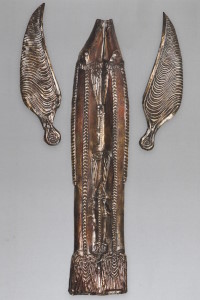
But we need not rely exclusively on inferences from the shape of metal objects to prove that the stylization of Scytho-Siberian art has arisen out of carving. We possess in addition direct evidence. The wooden backings to which the thin gold plates of the horse-trappings from Solokha (Plate 21) were fastened, and those belonging to their Siberian counterparts have survived in part even to this day. On the originals it is possible to observe how each separate element in the gold plates both of the fishes and of the ears, had been carved out as a positive on the wooden backing. The gold plates are merely the gilding beaten firmly on to the wooden core of the objects.
In a few other cases, too, such wooden backings for goldleaf have been preserved. Moreover, we possess a whole series of carved originals. In Siberia they are generally of wood, though there are a few specimens in bone or horn. The Scythian examples are all of bone. Unfortunately, owing to their insignificance in comparison with the rich gold finds, little attention has been paid to these objects. Relatively very little of this highly interesting material has been published, and it is to be feared that a good deal has been lost through sheer carelessness. During the sixties, Prof. Radloff excavated a grave near Katanda, in the Altai, which had been sunk into a frozen layer of soil and had therefore preserved in excellent condition many wood-carvings. We may suppose that the preservation of other specimens from Siberia is due to similar favourable conditions in the soil. Perhaps the absence of this factor is the reason why no artistic wood-carving has as yet been yielded up by the soil of South Russia. Only a few wooden vases have been found there.
The finest specimens of this class of object are grouped
(63/64)
together here on a few plates (Plates 31-33 and 59-63). In view of what has been said above, it is, I think, superfluous to describe each object in detail. The observer can see at once how the stylized rendering has been conditioned in each case by the material and the technique employed. Moreover, the motives are the same as we have discussed individually. It is only necessary to stress the evident preference for scroll patterns, especially on the ears, which is so highly developed on the Siberian carving, and was applied in just the same way to metal work. For comparison the reader might consider the ears on the beastsí heads from the hilt of the bronze dagger (Plate 40 A), or the scrolls encircling the nostrils of the animalsí heads on the guard of the dagger with iron hilt and bronze blade (Plate 40 B), or those round the eyes of the birdsí heads on the iron dagger (Plate 40 C). We meet such coincidences at every step. We might for instance, cite the gold plate from a scabbard from the Don delta on which the scroll round the boarís ear is replaced by the birdís head with its beak twisted into a scroll (Plate 22 A). Equally typical of carving is the bevelling that brings out the modelling of the figures on the carvings. It is especially well marked on the two profile lionsí heads and the long ďbearís headĒ (Plate 60 E , G & A).
The habit of decorating the birdsí beaks with parallel lines in relief is explained by the Scythian bone-carvings (Plate 32 A, G & H). This style of ornament is at once comprehensible in the light of the bone ramís head with birdís beak from Kelermes (Plate 32 G&H). The manner and method of carving into relief the nostrils and mouths of animals represented with very fat muzzles is made intelligible by this small piece of carved bone and by numerous bone bridle-pieces (psalia) (Plates 32 F, and 33 B&C). It is further instructive to notice how a habitual
(64/65)
repetition of this motive can turn the mouth into something like a a second nostril (Plate 32 D).
It is very significant that, in addition to wood, we meet bone as the material of the carver. This substance has evidently been very widely used as well as deerís horn and elkís horn ó the elkís head from North-east Russia is, for instance, carved in elkís horn (Plate 64 F). If we take into account the peculiarities of the animal style we shall come to the conclusion that not wood but, far more probably, bone or horn was the original and native material employed by this style. The remarkable skill, technical as much as artistic, in producing perfect animal figures in a small space must have been developed by carving in bone. Only this material and horn really confine the artist to strictly limited surfaces. Wood offers much greater freedom and does not necessitate that compactness of the outlines and the whole composition that characterizes every single specimen of the animal style.
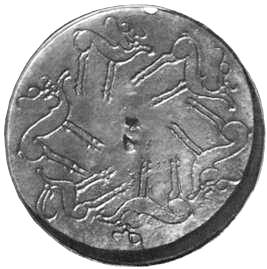
It is very interesting in this connection to consider the technique of the bronze mirror from the Altai (Plate 41). The representation is made in outline and makes an impression as if the lines were carved, but in reality they are in relief. Probably we have here to deal with a bronze cast from a form in which the craftsman in the usual manner of bone-carving ingraved the representation. It is very interesting, that we also from Scythia have a bronze mirror, worked in the same technic. This is the mirror in the Moscow Historical Museum, from the Samokvasov collection, on which a birdís head is represented in relief outlines (Plate 30 B).
Only in the light of this intimate relation between the material underlying the Scytho-Siberian animal style and its repertoire can we comprehend that curious trait of primitiveness that
(65/66)
infects all its artistic products. It cannot be a mere coincidence that this animal style gives us the impression that it has been invented rather by a nation of hunters than a race of herdsmen, as Prof. Rostovtseff once remarked. In the same context the conspicuous, perhaps the originally predominant, part played by elks and bears as objects of representation also becomes intelligible. The bones and horns of the animals brought down by the hunters provide the artists with the material from which they carved the figures of those animals that furnished the economic basis of their nationís culture.
But let us not anticipate. The above remarks are merely inferences to a remote background. By classical times, Scythia and Siberia with their rich metallurgical industries have long outgrown the phase of mere food-gathering culture. Nevertheless the after-effects of the earlier phase of evolution always exert a profound, we may, indeed, say fundamental influence on the physiognomy of art, on its styles and on its motives.
The roots of this art must therefore lie in some quite other soil than those highly developed cultures with which the Scyths came into contact on their westward march. The civilizations of Greece and Persia looked back both in Europe and Hither Asia upon a thousand years of evolution and had long outgrown the last survivals of the primitive life of hunters. They are two quite alien and heterogeneous worlds that touch in South Russia and Transcaspia ó on the one hand the Hellenic and Iranian worlds linked by the common foundation of earlier cultures, on the other the world of Scytho-Siberian tribes who, rising from unknown seats in the east, were spreading westward.
How different these civilizations were in essence, shows us clearly enough the destructive influence which the highly developed civilizations of Greece and Persia exerted on the native
(66/67)
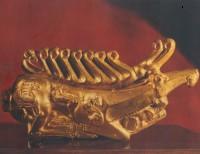
artistic style of the Scytho-Siberian tribes. Greek art, great though it was from the outset, unrivalled though its creations will remain in human history, was nevertheless alien and unresponsive to the imagery of the animal style. We have already met an instance of this on the scabbard from the Don delta, on the upper rim of which the birdís head motive has been wrongly applied (Plate 22 B). We may adduce two more instructive examples: the gold plate depicting a stag from the older grave at Kul-Oba (Plate 34), is a repetition of the motive from Kostromskaya Stanitsa (Plate 1). But how feeble the whole representation is! The suggestive modelling of the animalís body has been lost, the members are flat and characterless. Look how casually the small beasts are applied, not in the places significant for the organic structure of the body but indiscriminately on any sort of blank surfaces! And note how the purely Greek treatment of these motives contrasts with the form of the stag itself. The most characteristic point, however, is the figure of the dog under the stagís neck. To understand the model by which it was suggested we must compare the gold object from Siberia depicting a combat between a wild goat and a wolf (Plate 55 A). It is obviously the same motive. But how the exquisite composition has been spoilt ó we must be allowed the expression ó by the naturalistic interpretation of the Greek artist!
Or take another exampleó the two gold ear-pieces from the horse-trappings from the Zymbalka barrow. The first piece is a Greek product (Plate 35 A). The Scythian birdís head has been transformed by the artistís naturalistic tendency to a dolphinís head. He has retained only the scroll of the original beak. The second piece (Plate 35 B), is a barbaric imitation of the first. Strictly though the artist has copied his model, the familiar native shapes break through victoriously. The
(67/68)
resemblance to the original birdís head is clearer. The beakmouth with the scrolls is thicker once more and the artist has modelled the ear according to his wont higher up behind the eye.
The stag from Kul-Oba and the ear-pieces from Zymbolaka [Zymbalka] date from the finest epoch of Greek a rt; some from the Vth, some perhaps from the beginning of the IVth century b.c. So there can be no question of an inferior ability in the Greek artist as compared with the Scyth. It is just that two totally different universes of conceptions and artistic forms are here in contact. Only in the archaic period when the decorative element was still dominant even in Greek art were Greek works at all congenial to the Scythian. Later, however, Greek art struck out on new paths. The Hellenic influence on Scythia was, however, so strong that it saturated the whole country. From the Vth century we can see how under this predominance of Greek influence the native animal style withered and decayed. The degenerate motives of antlers discussed above (Plate 7), which belong to the Vth or IVth century will serve as examples of the process. Henceforth the numerous stamped gold plaques from Scythian graves tend to be decorated with purely Greek cenes or with native motives transformed into naturalistic renderings in the Greek manner.
Apart from this disintegrating influence from without, spontaneous degeneration was attacking the animal style in its eternal development. But in this case the old motives still remain recognizable despite all modifications in their forms and, as before, the stylistic treatment is conditioned by carving. The gold torque from Stavropol Government (Plate 36 A [√› »Ū‚.Ļ2807-4]), displays two animals the elongated bodies of which would have made the beast underlying the representation quite unrecognizable, but that the long-pointed snout reminds us of the ďbearsí
(68/69)
heads.Ē The parallel ridges adorning the beastís body and the scroll on his hind quarters have, however, obviously been executed by carving. Precisely the same treatment is exemplified on the fabulous creature from Siberia (Plate 36 B [√› »Ū‚.Ļ—Ť.1727-1/143]). The horns and wings point to Iranian influence; it is here the lion-griffin of Iranian art that has inspired the motive, but it is executed quite in the native style. Judging by analogies in other finds, both objects may belong to the IIIrd century b.c.
Other instances of the spontaneous degeneration of the animal style are offered by the cylindrical arm-coils and torques of solid gold wire with animal figures at either end. Of the specimens here illustrated the little bracelet (Plate 57 A) exhibits two lion figures which, sketchy though the workmanship be, are still quite pure stylistically. The abrupt edge of the mane is characteristic. The other armlet, composed of several coils, and the torque (Plate 57 B&C), are decorated at either end with animal figures which are excessively elongated and no longer retain any naturalistic traits, but have become purely conventional. Close parallels are available from the Volga district in South Russia. They too should probably be assigned to the Hellenistic age.
The Iranian influence on Scytho-Siberian art became particularly marked during the last phase of the animal styleís development. The latest products of this art are overburdened with polychrome incrustations. Such incrustation was a long established technique in Hither Asia which attained its crowning development in the aft of the Achæmenid Persians. It looks as if this technique and Achæmenid influence in general made itself felt earlier and certainly more powerfully to the east in the direction of Siberia than in the west in Scythia. In any case Achæmenid products, partly incrusted, have been found not
(69/70)
only in Scythia but also in Siberia. Some of the Siberian objects which are still very pure stylistically, already show such incrustation. As a rule, torquoises supplemented by coral or cornelian are used for the incrustation. The gold plaque depicting a combat between a horse and a lion-griffin and the silver girdle-clasp (Plate 46) show how sparingly such incrustation was used at first and how it was originally applied only to the organically significant parts of the body in the manner of the animal style. The artist has decorated more generously but with equal taste the ends of certain torques (Plate 56), notably the beautiful lionsí figures on which unhappily the gems are no longer in position (Plate 56 F). The scrolls of the ears and the carvings on the body are pure products of the typical animal style.
Approximately the same phase of evolution is represented by the gold plaque with a bird and a yak (Plate 50), or the larger one depicting four figures (Plate 51), or again, the bronze plaque of two steers (Plate 53 A). But the stronger it became the more the Iranian influence, like the Greek, disintegrated the native style. The gold plaque with two dragons (Plate 52) is already studded all over with coloured inlays, and finally the round gold plate (Plate 54) is so overloaded with torquoises that at the first glance nothing seems to be left of the animal forms. Only after closer study do we perceive that a stag is lying doubled up to a circle in the centre with his antlers spread out in the middle of the figure. Outside the stag a scene of a combat between two animals biting each other on the necks and fore-legs is depicted four times. This is a motive which frequently appears by itself, as, for instance, on the good specimen of this class from the Hermitage here figured (Plate 53 B). From each group of the round gold plaque the eight legs
(70/71)
converge upon the central scene. Each paw or hoof ó we can no longer say which it represents ó enshrines a turquoise, and theseare set so closely together that the stag in the middle seems to be encircled by a continuous chain of gems. The fantastic tendency in the animal style had perhaps been reinforced by this foreign influence, its decorative powers were scarcely impared thereby. But the characteristic and effective style of the original art was completely disintegrated and obliterated.
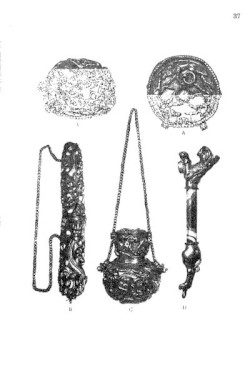
The objects from the treasure found near Novocherkask in the Don district belong to the same phase of development. The scenes on the globular flagon with lid and chain (Plate 37 C), and on the hemispherical pyxis (Plate 37 A), are the same. On the bottom are birds extending on both sides of the vessels towards a twice repeated group of a lion biting the back of a stag. On the pyxis lid a procession of three ungulate animals is depicted. The way that the legs hang loose with the tips of the hoofs downwards, just as on the much older bronze mirror from Siberia (Plate 41), is characteristic here again. The whole surface of the long sheath (Plate 37 B) is occupied by a series of beasts, each of which is biting the rump of the one in front. In front of the foremost beast the rump of yet another is indicated. The bracelets (Plates 38 B&C) are decorated with a row of quite unrecognizable beasts, while on the gorget (38 A) we find the same composition, but with this difference, that animals facing forwards alternate with bird-headed monsters with reverted heads.
The basis of these motives is therefore still the same as in the old animal style. At the same time the Iranian element bringing with it the extravagance of incrustation dictated by the oriental love of colour has reduced the theme to insipid characterless figures. The treasure of Novocherkask is probably the richest
(71/72)
but by no means the only one in South Russia. This phase, too, of the animal style is well represented there. It belongs to a late epoch and is evidently no longer a genuine Scythian product, but represents the artistic style of the new invaders from the east, the Sarmatians, although a gradual transition from the old Scythian style to the new may be observed. But in any case it is the result of the influence from Iran to which the whole Scytho-Siberian region had been exposed and which won the upper hand after the decline of Greek influence, especially at the opening of the Roman epoch.
Even this late animal style is deeply interesting. It cannot be denied that aesthetically it possesses a unique attraction. And in the history of human culture it is of first-rate importance. From it we may trace threads which lead us right into the foundations of West European civilization early in the Middle Ages. That is one side. On the other side it exercised a powerful influence in the East. It is no accident that much in Persian art of the Sassanid epoch distinctly recalls the motives and stylistic mannerisms of this late Scytho-Siberian art. So, for instance, the figure of the lion represented in the posture of the flying gallop with an agate cylinder for its body from Novocherkask (Plate 37 D), in the rendering of the mane and other features anticipates Sassanid monuments.
Nevertheless, in comparison with the original state of the animal style, this later phase represents the result of dissolution under foreign influence. In the course of its evolution the animal style had lost many of its own peculiar qualities and absorbed a host of alien elements. The latter include a series of motives ó in the first place the antithetic group and then the whole class of hybrid monsters whose bodies are composed of the members of various beasts. They are led by the Iranian
(72/73)
lion-griffin with wings and often with horns, who now begins to play a very conspicuous role and becomes the progenitor of the most diverse variants.
All this is quite strange to the original animal style. All such motives imply at bottom a certain intellectual content, a subject, a relation, however loose, with abstract or religious ideas. That is utterly alien to the nature of the animal style. It is characteristic that only at a late date, and then extremely seldom, was man represented. Originally the artist depicted only animals. The art attained to nothing richer in connotation than scenes of fighting animals. And even these scenes were depicted, just like the separate animal forms, through the most realistic reproduction of the immediate impression produced by nature without any sort of intellectual elaboration. Even the simplest type of logically thought-out construction known, geometrical ornament, appears as something secondary in the animal style, the result of the degeneration of animal forms. Ornaments derived from plant-life are equally secondary and partly find ingress with western, especially Greek, influence, partly arise spontaneously out of the same process of degeneration.
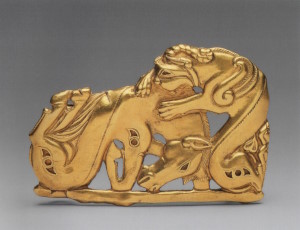
To adduce just one example of such an interesting and instructive line of evolution, we shall here refer to the Siberian gold plaques. We have already noticed how regular the form of one group among them is. These plaques, one end of which is broader than the other, are very skilfully decorated in such a way that two animal figures fill up the whole outline. This system is adopted in its greatest purity on the plaque representing a battle between a lion-griffin and a horse (Plate 46 A). In other cases a horned animal appears at the broader end of the plaque (Plate 48). The branches of his antlers are represented under the guise of birdsí heads. This motive was then elaborated
(73/74)
by itself in decorative fashion until it is only half understood, as, for instance, on the plaque from Verkhneudinsk in Transbaikalia (Plate 49 A). The motive begins to degenerate and then is reinterpreted in realistic fashion, and from the one-time antler a tree arises, as the plaque depicting a tiger and camel fighting shows (Plate 49 B). Here the representation of the plant is plainly the result of a long evolution. But originally this art knew animals, only animals and ever more animals.
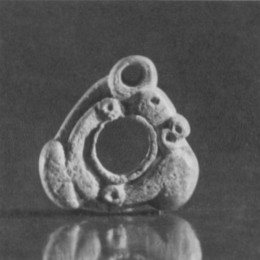
Where are we to seek the home of this art, the original root from which it sprang? That is no easy question to answer. The process which led to the development of the mature Scythian and Siberian animal style was, like most historical processes, a complicated one. The final product was due to the interaction of many factors. We can only say with certainty that the animal style was already fully elaborated when the Scyths brought it to South Russia. Such products as the wonderfully delicate bone-carving in the form of a birdís head from Kerch (Plate 32 A) are among the earliest specimens that we know at all, and date from a period which must very nearly coincide with the first appearance of the Scyths in South Russia. This carved bone was found in company with a Greek vase of the socalled Milesian-Rhodian style of the best quality, in fact one of the finest specimen of this class known. This find, therefore, certainly belongs to the VIIth century b.c. The beautiful representations of animals (Plates 2 and 12), and bone-carvings from Kelermes (Plate 32 B, D, F, G & H), are approximately contemporary; as is the stag from Kostromskaya Stanitsa (Plate 1). It is scarcely credible that these gems are later than the beginning of the VIth century; perhaps they too belong rather to the VIIth. Hence we must conclude that the Scyths brought the animal style with them fully formed. Nay, further, quite
(74/75)
degenerate or, more exactly, over-stylized types already occur by this date. In one and the same grave at Kerch as the Milesian vase and the birdís head, was found the second carved bone representing an animal curled up into a circle (Plate 32 C). Here the motive is plainly represented already in a much simplified form and is moreover compressed to a triangle. It is obvious that this type presupposes a long period of evolution.
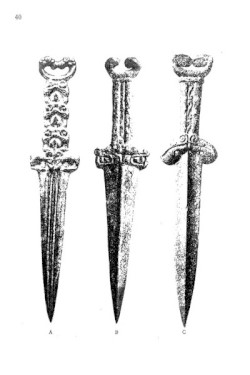
In South Russia there are no prototypes for the animal style; it appears mature abruptly together with the Scyths. In Siberia, however, we can trace an autochthonous evolution from the Bronze to the Iron Age throughout which the animal style was in vogue. Unfortunately Siberian antiquities have been insufficiently studied and in particular their chronology is practically unknown. But one circumstance seems to offer a -certain clew. The nearest analogies, the closest agreements between Scythian and Siberian antiquities, are those subsisting between Scythian products of the earliest archaic epoch and works of the first Iron Age in Siberia. The birdsí heads on the iron dagger from Siberia (Plate 40 C) may be compared with the carved bone objects from Kelermes (Plate 32 G). Now the dagger in question must belong to the very beginning of the Iron Age, as its complete agreement with the other weapons illustrated on the same plate shows. Of the latter, one is wholly of bronze (Plate 40 A), the other of bronze and iron (Plate 40 B), and on it the still rare and costly substance, iron, is used for the hilt very characteristically. We could show many of such correspondences which suggest that the beginning of the Siberian Iron Age coincides with the archaic period in Scythia, i.e. that the Iron Age in Siberia opens not later than the VIIth century b.c. In that case the Bronze Age must lie behind this date. And in view of the wealth and intensity of the
(75/76)
bronze-using culture of Siberia, known to us especially from the Minusinsk region in the Jenessei valley, its evolution cannot be compressed into a brief space of time.
Is Siberia, then, the original homeland of the animal style? We might well be tempted to think so. And in the case of Scythia such a hypothesis would have its own justification. It is quite possible that the Scythian culture is an offshoot of the Siberian ó in the widest sense of that word. The most intimate relationship is bespoken not only by the agreement in artistic style but also by the types of everyday utensils ó the knives and daggers, the mirrors and huge cauldrons and a host of other articles show the same shapes here as there, and are typical of this cultural province in the East, while they are utterly foreign to the civilizations of Hither Asia and Europe. The reader may compare the objects illustrated on Plates 39 and 10 C, Plates 40 and 23 A, and the other sword-sheath, or, again, Plates 41 and 30.
But convincing as this relationship is, we cannot yet determine with certainty the centre of the Siberian culture itself. During the Bronze Age the valley of the Jenessei, particularly the district of Minusinsk, was no doubt thickly populated; even to-day its soil yields up countless bronzes. But the other divisions of Siberia and the adjoining region of Mongolia are still imperfectly explored. It may well turn out that the Altai, for instance, was on no inferior level of culture to the Jenessei valley. Indeed, it seems reasonable to suppose that the real centre of this culture or the region of its most intensive development should rather be sought in the immediate neighbourhood of the richest deposits of metals, both gold and copper. Only one point is clear to-day: this civilization was in a high degree autonomous and, despite many influences from the south and west, still grew up along its
(76/77)
own lines. Scythia and what we know of Siberia in the age of metals are two trunks sprung from a single root but are already the fruits of long and rich growth. But the animal style points back to still older and more primitive roots.
In the mature Stone Age and in the Bronze Age an art was current in the whole northern territory from Finland across the Olonetz, the Kama district and the Urals right into Siberia, which must be connected with the art of the so-called Arctic Stone Age in Scandinavia and which exhibits the same conspicuous talent for the lifelike reproduction of animal forms as the mature animal style does later on. In fact, it is always the same animals that are representedó elks and bears.
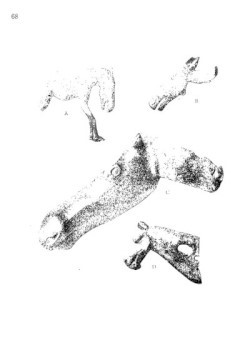
From the environs of Krasnoyarsk, that is, from the northern frontier of the Siberian metal-using culture, comes a find of exquisite figures of several elks, among them an elk-cow and her young carved in elkís horn (Plate 68 A&B). Judging by the circumstances of its discovery it is likely that this is a work of the Stone Age. In the central Ural district the peat round the lake of Shigir (Shigirskoye Osero) has yielded animal figures carved out of horn (Plate 68 C), the dating of which is unfortunately not yet established though their antiquity must be considerable. It is quite conceivable that they, too, belong to the Stone Age. In the Kama district on the upper course of the Volga copper daggers belonging to the early Bronze Age have been found; the hilt of one of them is decorated with an admirably rendered elkís head. In North Russia and in Finland stone weapons manufactured of local Olonetz stone have been discovered, the ends of which are often adorned with beautiful and naturalistically shaped elksí and bearsí heads (Plate 69 B&C). From a peat bog in Finland comes further the remarkable find of a wooden spoon (Plate 69 A), which, to judge by the
(77/78)
marks of working left upon it, was carved with a flint-knife. It is therefore an authentic product of the Stone Age. The handle of this spoon again terminates in a bearís head.
Here, then, we have the primitive cultural stratum from which the mature animal style must later have arisen. Here in the uncultivable tracts of northern forest stretching from Scandinavia to Siberia the primitive tribes of hunters have practised, perhaps for thousands of years, their astonishing art which is so remarkably akin to that of the old Stone Age in France. Here, too, we find the natural conditions of life under which a very highly developed technique of carving in horn and bone must have arisen. We know as yet very little of these early epochs, and it is all too likely that we shall never acquire an adequate knowledge of such cultures since the majority of the carvings, no doubt very numerous, must obviously have vanished without leaving a trace. We can only hope for lucky accidents like the two discoveries in the peat just mentioned. Nevertheless, in my opinion, this primeval connection between the animal style and the art in vogue in the northern forest tracts is already clear enough to win recognition. The unique talent for representations of the animal world which persisted till the last phase of the animal styleís evolution, the constant preference for the motives of the elk and the bear and the same common technical basis in bone or wood-carving, betray most distinctly the kinship of the respective groups.
This may be once more illustrated by comparison of the abovementioned old horn-carvings from Siberia and the Ural region (Plate 68 A-C) with the charming bone-carving of a horseís head (Plate 68 D) found in the region of Minusinsk in a grave of the Bronze Age, containing ordinary Scytho-Siberian bronze knives and other objects.
(78/79)
What is still lacking in these early periods is the mature elaboration of the decorative stylization. That is plainly a product of the first Iron Age or of the period of transition from bronze to iron. It is quite conceivable that this fresh spurt in art as in culture which Siberia then made should be ascribed to a stimulating impulse from without. Perhaps all these phenomena are interrelated ó the emergence of a new, developed style, the introduction of iron and the expansion of new ethnic elements that took to migration in great hordes and in the guise of the Scyths, perhaps mixed with alien racial constituents, advanced far westward right across the South Russian steppe to the Dobrudja and the Hungarian plain. And the fertilizing cultural influence spread right into North-east Russia where the Ananyino culture arose, autonomous but related both to Scythia and Siberia; in it old native elements were no doubt partly merged. It may be that all these phenomena are due to the reflex-effects of those great racial and cultural movements that accompanied the collapse of the old Oriental civilizations and the birth of the classical world about 1000 b.c.
We know too little as yet to speak positively on this topic; everything remains in the world of hypothesis. But the analysis of the animal style seems to prove triumphantly that in the rich and highly developed civilizations of Siberia as in those of Scythia and North-east Russia, though it was subsequently saturated with cultural influences from Greece and Hither Asia, a quite independent component was present which was neither Greek nor Iranian but northern, and was fundamental and dominant. What shall we call this element in ethnic terms? That is a natural question to ask, but to answer it is hard. In the first place, Scytho-Siberia culture is still dumb. We know not what language its authors spoke. Possibly later researches will throw light
(79/80)
upon this point. For the moment we can but point out that, even in later times, this same style survived in the northern tracts of the Kama district, the Urals and Siberia. From these regions comes a series of monuments which reveals how, after the decay of the concentrated civilizations of the Scythian epoch, both in Siberia and North-east Russia, the animal style arose once more from this unitary primitive stratum and repeated the same motives in different forms. Partly from Permia and partly from Siberia come objects of a peculiar dark-coloured alloy depicting bears in an admirable and highly artistic stylized rendering (Plate 65). The date and cultural context of such objects are still obscure, but analogies with Chinese works of the Han period (Plate 72 A) suggest that they cannot be far removed from that epoch, round about the beginning of our era.
Probably to a yet later age belongs a class of thin flat bronze plaques which for the most part have been found in the district of Perm. In view of analogies to other finds and of isolated coins, these should most probably be dated between the Vth and VIIIth centuries a.d. It is once more the elk and the bear that furnish the motives. This time, however, men are introduced into the picture. On the simplest and obviously oldest specimen a rider with a disproportionately big human head may be seen mounted on the elk (Plate 66 A). The elksí heads in front and behind are plainly just reminiscences of the stylized elkís antlers such as we meet on Scythian products. Later on, the figure of this rider is often duplicated, fantastically elaborated and crossed with the elksí heads in the most diverse fashions (Plate 66 B). In general the later developments exhibit the impulse to a fanciful reduplication of the motive. Instead of the elk another elongated animal often appears on which the rider is sitting or standing and in which the ďbearĒ is still
(80/81)
recognizable (Plate 67 A). This beast tends to be subordinated to the rider till at last in several cases only fantastic human figures are left (Plate 67 D). That another motive, too, of the old animal style persisted, that of the beast curled up into a circle, is shown by several, generally round, plates depicting bears (Plate 67 B&C). So we have here a new branch from the old trunk.
This series of documents comes down almost into historical times. Unfortunately, however, we cannot yet say definitely whether the forerunners of the Russian colonists, the various Finnish tribes, were already living in these regions at this early epoch. So we have no sure grounds for connecting this late animal style with the Finno-Ugrians and thus obtaining a clew to the nationality of the animal style as a whole. On that question we are still left in the dark. Later researches on this material will no doubt enable us to judge definitely whether the ascription of the Scyths to the Finno-Ugrian race, often suggested as a hypothesis in the past, is justified or not in respect to a part at least of the population of Scythia.
We must leave the question of the attribution of the Scyths and their relatives to a definite race open, and content ourselves with the statement that the animal style survived in its old native haunts almost into historical times. The same trunk which had put forth the splendid blossoms of the golden Scythian and Siberian cultures is not yet quite dead, and before its final decay still sends forth a few humble, almost miserable shoots which still bear the same leaves as the green and lusty boughs of former days. It is an unitary lengthy evolution lasting probably thousands of years which we can watch. It is the growth and decay of a great and independent branch of the human race.
(81/82)
Something imperishable sprang from this branch. The cultural work accomplished by the Scyths in co-operation with elements from Greece and Hither Asia constitutes the foundation of civilization in those regions right down to our own day. It is no accident that the first organized Russian State after the great migrations, the realm of Kiev, arose in just that region where even in Scythian times a strong and populous centre of culture had existed. And the influence experienced by diverse peoples on the soil of South Russia and then carried with them in their westward wanderings at the time of the migrations of peoples became a weighty element in the rise of West European civilization in the early Middle Ages.
Nowhere, however, is the enormous importance of this peculiar centre of civilization so evidently and unmistakably traceable as in its expansion eastward, in its influence on the ancient culture of China.
It is hard to find oneís way through the little known and little studied monuments of China before the beginning of our era. The very chronology of these monuments is far from satisfactorily established. Chinese tradition itself which offers a detailed chronology reaching back to the mythical days of gods and giants is useless. But to any one who is familiar with the Scytho-Siberian animal style it is most striking how the majority, I am tempted to say all, of the documents yet known from the earliest period of Chinaís culture are intimately related to the types of the animal style.
In the first place we may assert that a regular importation of Siberian products to China took place. From China, principally, indeed, from the northern frontier provinces and Mongolia, come bronze and gold articles that agree so exactly with Siberian products that we must inevitably regard them as
(82/83)
pure Siberian manufactures imported into China. Thus the bronze plaque in the Stoclet collection, depicting a combat between a tiger and a horse (Plate 47), is both in shape and decoration so purely Siberian that it must be Siberian product even though it were found in China. The manner in which the tigerís striped hide and his paws, the contortion of the horseís body, and the oblique line of his spine are rendered, leaves no room for doubt on this point. And this is far from being the sole example of its kind found in China. There are quite wellattested finds of Siberian works on Chinese soil. So a bronze plaque representing a horse in the same attitude with twisted body, now in the Metropolitan Museum at New York, was discovered in a Chinese grave; yet it displays purely Siberian stylistic characters.
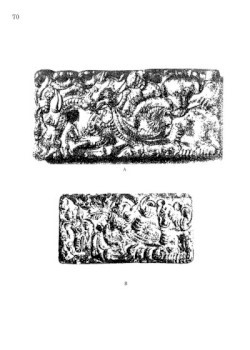
The plaque in question was said to have been found together with another bronze plaque decorated with a similar motive, treated in a different style. The latter plaque is one of the products from China that are most closely connected with Siberia, but are nevertheless patently native Chinese creations. On it is represented an ungulate animalís struggle with two bears (Plate 70 B). Better to understand the highly stylized representation we may compare it with another bronze plaque from the Stoclet collection (Plate 70 A). Both objects are reproduced together on our plate. It is clear that we have the same motive in each case. On the plaque from the Stoclet collection the dependence on Siberia is self-evident. The plaque represents a horse in the attitude with twisted body; the fluted lines along his spine just like the spinal lines on Siberian works are always organically true. The forelegs are touching with their hoofs the lower rim of the plaque; the hind feet reach the upper rim and the right upper corner. Two bears have fallen upon the animal
(83/84)
and are biting his shoulder and hind leg. Only the head and fore paws of the bear in front are visible; the smaller bearís figure is completely delineated on the right end of the plate. His head recalls vividly the exquisite figures of bears from Northeast Russia (Plate 65). The bigger bearís head is more stylized and that in precisely the same way as in Siberia, for instance, on the gold plaque representing a combat between a tiger and a horned ďbearĒ (Plate 48). His nostril is twisted into a scroll. Ju st as purely Siberian at bottom is the rendering of the horseís head. His muzzle terminates in a birdís beak. If we compare this work with the gold plaque from Transbaikalia (Plate 49 A), or the wood-carving from the Altai (Plate 61), where the stylistic treatment is precisely the same, we cannot help admitting that we are here dealing with the same hybrid motive as on the bonecarving from Kelermes (Plate 32 G&H), or the iron knife from the Dniepr district (Plate 10 C). The artistís predilection for representing beastsí muzzles as very broad, a habit best explained as due to the influence of the common figures of elks, leads to the further stylization of the motive into a purely conventional hybridization with another equally familiar motive, the birdís head ó a hybrid apparently purely stylistic and free from any intellectual implications. It is a type which could only arise within the sphere of Scytho-Siberian art. The motive of birdsí heads on the border of the bronze plaque in the Stoclet collection springs from the same source: they were originally the branches of antlers. So the representation on this object in all its details betrays Siberian influence. Only the stylistic treatment is different. Much in it is already far removed from the Siberian original as, for instance, the birdsí heads. The whole may well be a Chinese imitation.
The details of the same scene on the plaque in the Metropolitan
(84/85)
Museum have been still further modified (Plate 70 B). The whole has become far more ornamental. So the horseís hind legs have been suppressed; only the scroll on the hind shank has been retained. The bigger bearís head is turned right round to face the spectator and has been much transformed by stylization. The birdsí heads have lost all interconnection, and in place of antlers ornamental curved ribbons have been introduced into the picture without any context. Nevertheless, an exact analogy from Siberian material can be cited. Compare our object with the gold ornament in form of a head of a Skiga-antelope from the Turgai district in Transcaspia (Plate 55 B). The parallel ribs on the nose are the same on both objects. And the way in which the horns grow on the gold antelopeís head is just the same as on the horseís head of the bronze plaque in the Stoclet collection (Plate 70 A). The dependence of such works upon Siberia is too striking to be disputed. Modern science ascribed them to the Han dynasty, i.e. between the IInd century b.c. and the IIIrd a.d.
As far as we can judge at present such indebtedness to Siberia can be detected in nearly all Chinese bronzes of this age, and also on other artistic products such as nephrite articles.
It would take us too far to discuss this subject in greater detail here. We must limit ourselves to these examples. But not only products attributed to the Han dynasty but also works unanimously assigned by contemporary authorities to the preceding era of the Chou dynasty (1122-250 b.c.), betray in a surprising degree the influence of types of the animal style. How this phenomenon is to be explained is a matter for special and comprehensive researches which can only be undertaken by professional students of the Chinese material. Here we can go no further than to point out such agreements.
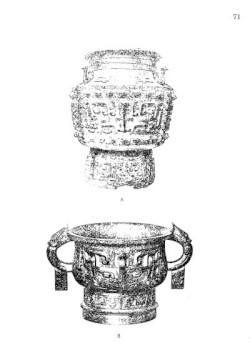
(85/86)
In the earliest art of China the motive of the Tāo-tièh played a prominent part. This symbol of the Storm God was represented under the guise of a very geometrical full-face lionís mask (Plate 71). Closely related are the representations of the tiger, the symbol of the West. If, now, we compare such Tāo-tièh symbols with the wooden plaque from the Altai district in the Hermitage, representing a full-face lionís head, recognizable though highly stylized (Plate 60 D), or with the wooden boss from the grave at Katanda, also in the Altai (Plate 62), we perceive at once that the latter provide the prototypes for the Chinese Tāo-tièh masks. From what other quarter could the regular stylization of the ears with scrolls be derived? From the West eastwards from Greece or Hither Asia we can, partly on other examples, follow step by step as we progress towards China the gradual degeneration of the motive of the whiskers on the upper lip.
The head of the Tāo-tièh mask vividly recalls the head of the Chinese dragon. Genetically the dragon, too, belongs to the same series of evolution. But he exhibits other aspects which we can define more precisely. On some Siberian plaques figures occur which come very close to the Chinese dragon. We may discuss two such. On a gold plaque in the Hermitage collection a combat between three animals is depicted (Plate 52 A). In the centre a feline beast lies hard on the ground with his head thrown back. He is being attacked on either side by fabulous creatures. On the left stands the horned ďbearĒ whom we already know, on the right a griffin, with birdís head ó therefore a Greek variant of this mythical animal. The symmetrical heraldic grouping of the composition deserves attention. On the other gold plaque (Plate 52 B), likewise in the Hermitage collection, only two beasts are facing one another in a quite
(86/87)
heraldic opposition. In this arrangement the influence from Hither Asia is yet more plainly revealed than on the other plaque. At the same time in this case it is no longer the Greek but the Iranian griffin with horns that is figured. But the motive has been much changed. The monstersí bodies are greatly elongated. They follow the outer edges of the plaque downwards and then sweep upwards with gracefully curved necks to the centre of the scene, where a plant, obviously a reminiscence of the sacred tree of early Mesopotamian art, is depicted. And the griffinsí heads are no longer lionsí heads, but much rather recall the stylized Scytho-Siberian ďbearsí heads.Ē As a whole, however, the figures are almost perfect Chinese dragons. That cannot be a coincidence. If the reader compares our creatures with Chinese representations of the dragons, especially with certain early specimens (Plate 72 A&C), he will inevitably be convinced that the Chinese dragon really grew out of the same elements ó the Iranian horned lion-griffin, and the Scytho-Siberian ďbearĒ ó probably not without the collaboration of Greek influences. We have already touched upon this problem in discussing the gold plaque from the Seven Brothers depicting the remarkable hybrid monster (Plate 20 A). Closely related figures arose from the same elements in the hands of Greek and Chinese artists.
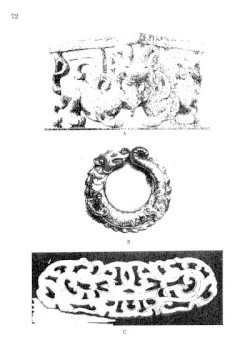
Only one example more we will add here to show the dependence of ancient Chinese art on Scytho-Siberian motives. The jade ring (Plate 72 B) clearly imitates both in the whole composition as in the forms of the head the purely Scytho-Siberian motives of the beast curled up into a circle and the scrolls on the nostril and the ear. In the Chinese representation the legs of the beast are lost, but on the right places the shoulder and the hind-quarter remain in form of something like a shield.
(87/88)
We must be content to illustrate the immense scope of the influence from Siberia on early China with these few examples, which are nevertheless perhaps the most suggestive. Much remains extremely enigmatic in the whole question. In particular it is obscure how Chinese art of the Chou dynasty could be exposed to this influence since it must be supposed, if they are rightly dated, that the objects in question are partly at least older than the best epoch of the animal style in Siberia.
The mutual relations between China and the centre of the mature animal style seem to be thus constituted. However the riddles attaching thereto may be solved, it is already clear that the Scytho-Siberian animal style, the oldest home of which is, as we saw, to be sought in high northern latitudes, while its mature phase was most probably elaborated somewhere near the Altai, exerted an absolutely fundamental influence on the whole physiognomy of art in the Far East. Even to-day China and Japan and even partly Buddhist India draw the inspiration for their art from those streams that, in the Scythian period, flowed from Central Asia in diverse directions southwards, eastwards and westwards. But art and its style are only the forms in which the total culture of a human community finds expression, and so we must assume that this influence from Central Asia was not restricted to the sphere of art. Although we possess a mass of indications that this assumption is well grounded, this is not the place to discuss it.
But to one to whom the forms of representational art speak no less clearly than the written word, what he beholds with his eyes is no less convincing and impressive than what he reads in an historical record. Both alike are reflections of real life. And so, I hope, the student will be enabled by the documents assembled
(88/89)
in this little book to re-create for himself the growth and decline, the blossoming and forced expansion, the suffocation through the overpowering influence of superior cultures, and the slow, tragic lonely decay of a world which, strange and enigmatic as it is, none the less possesses a unique fascination.
Ūŗ‚Śūű
|